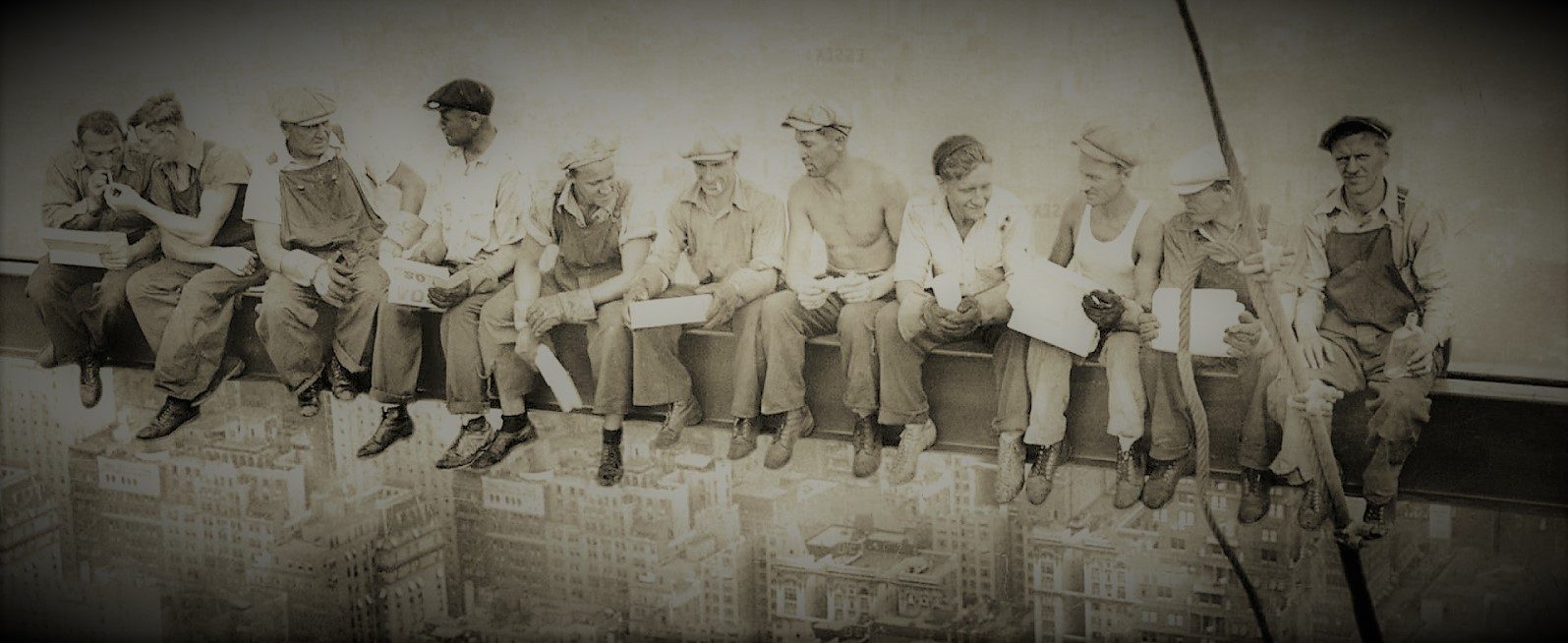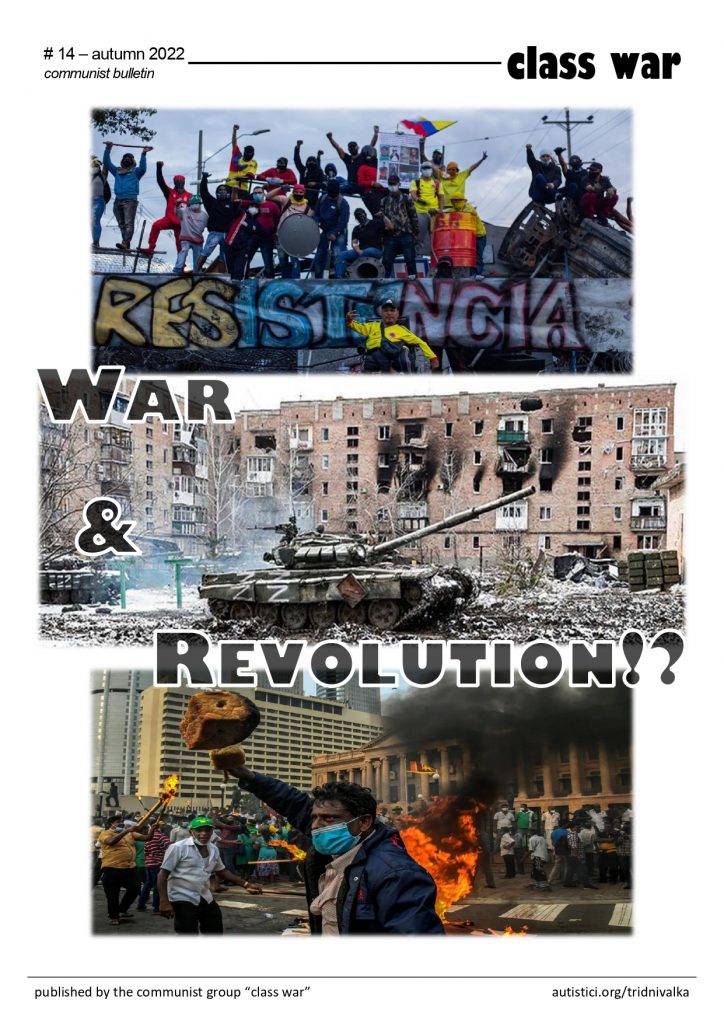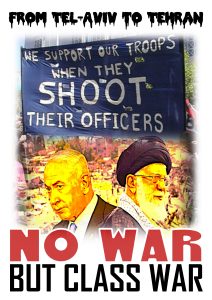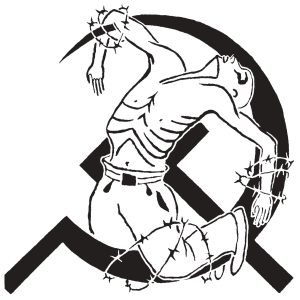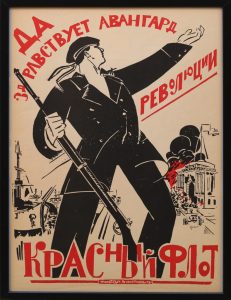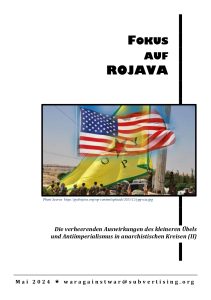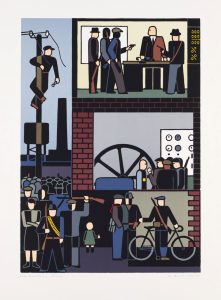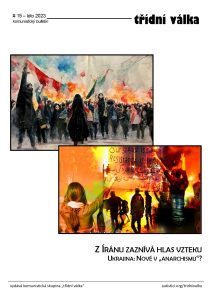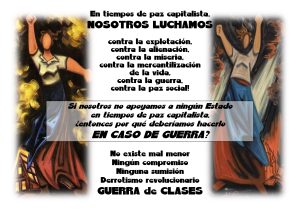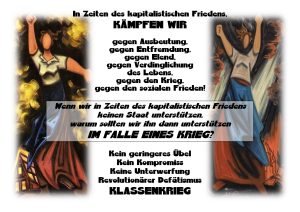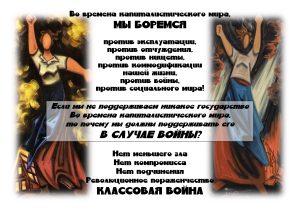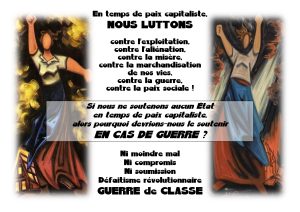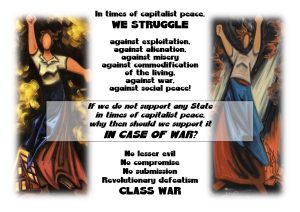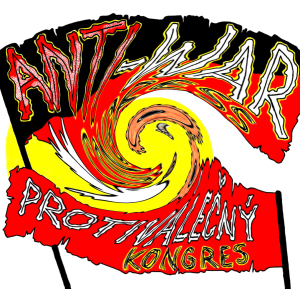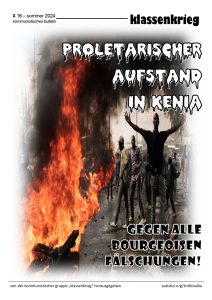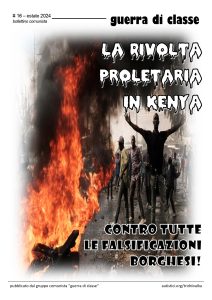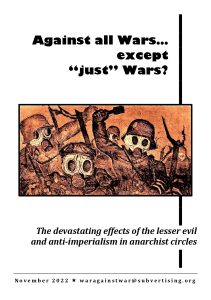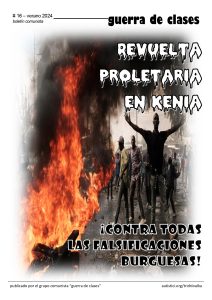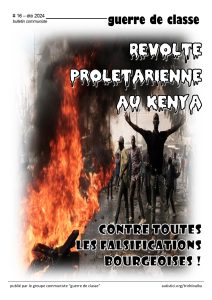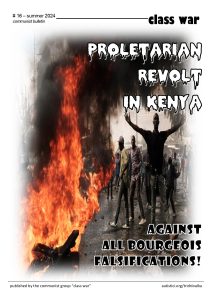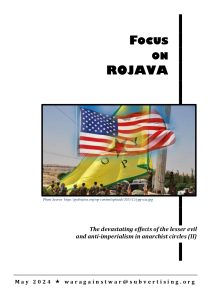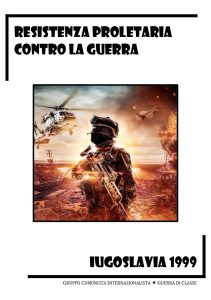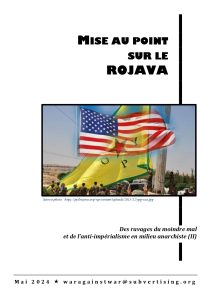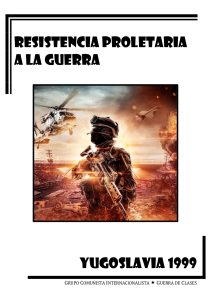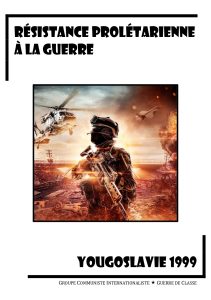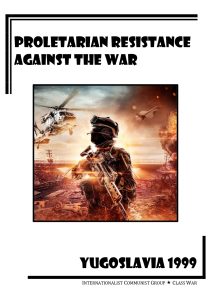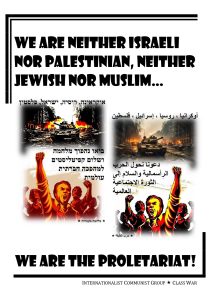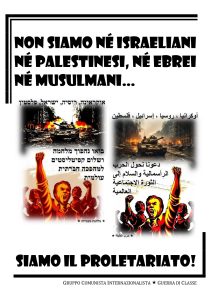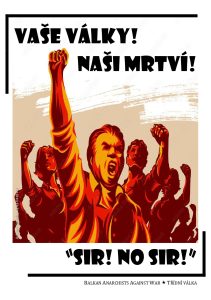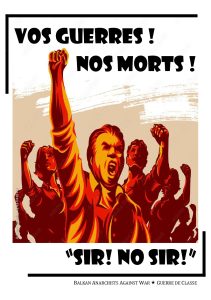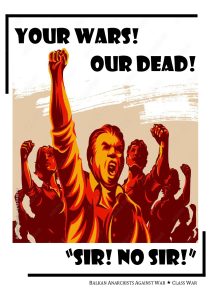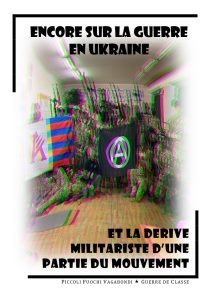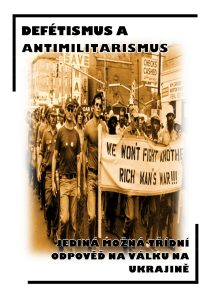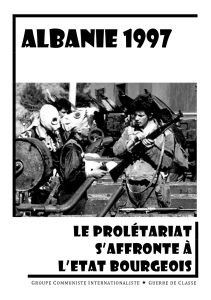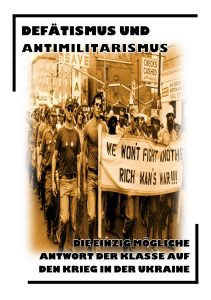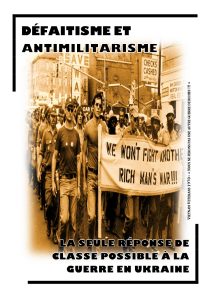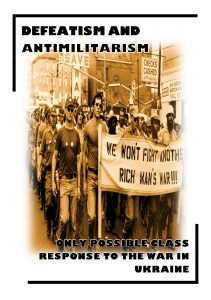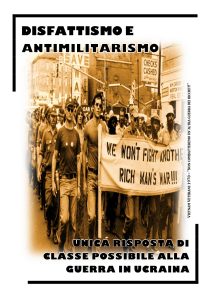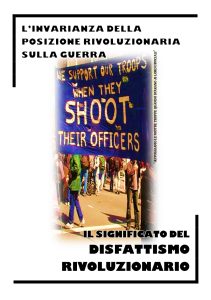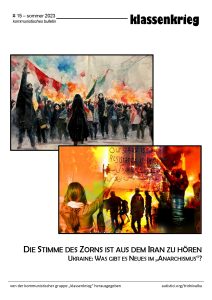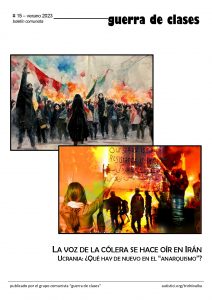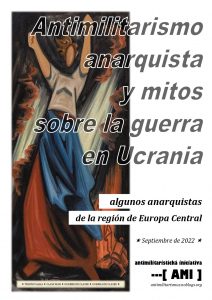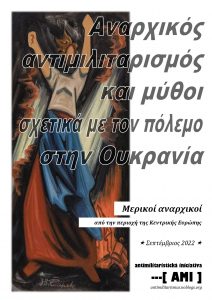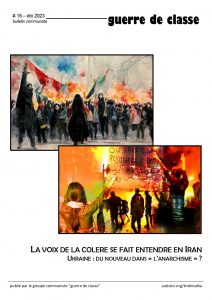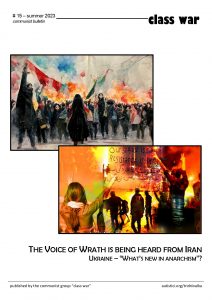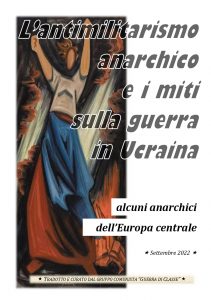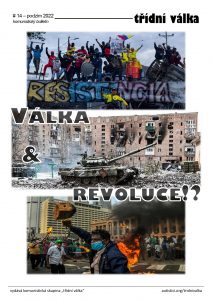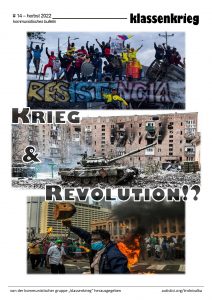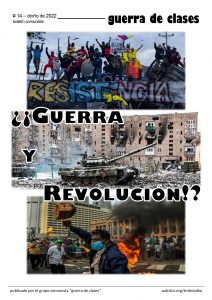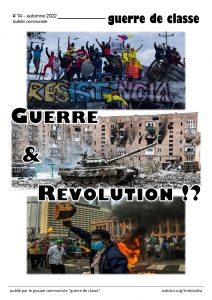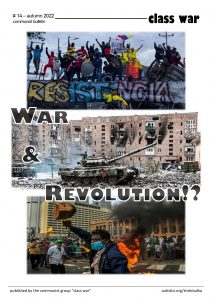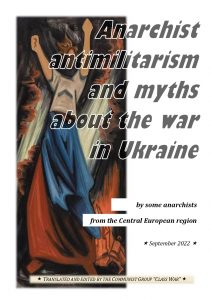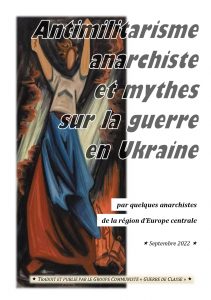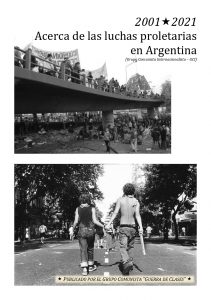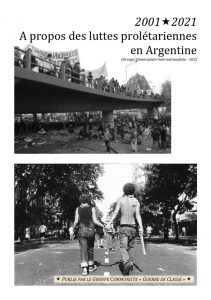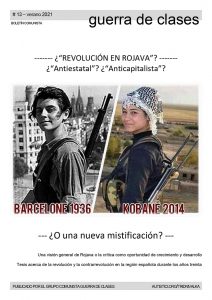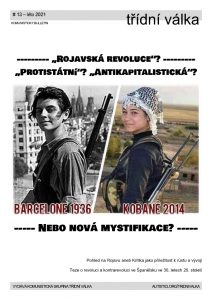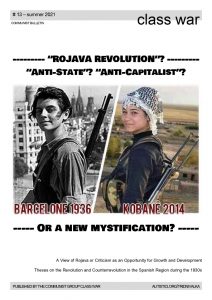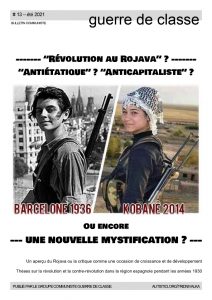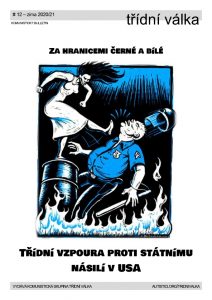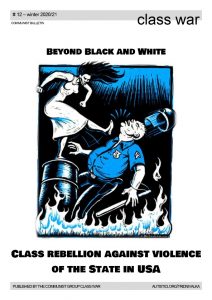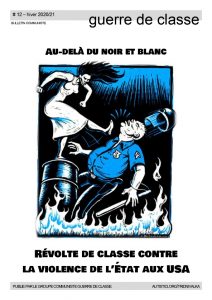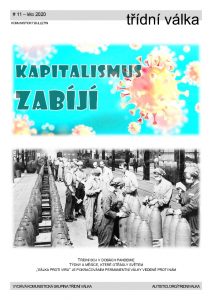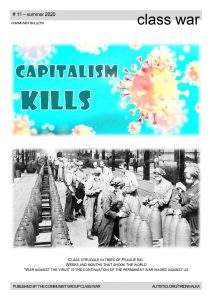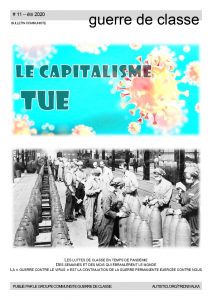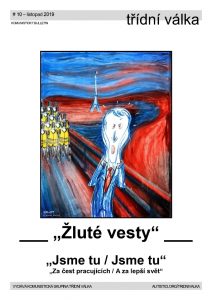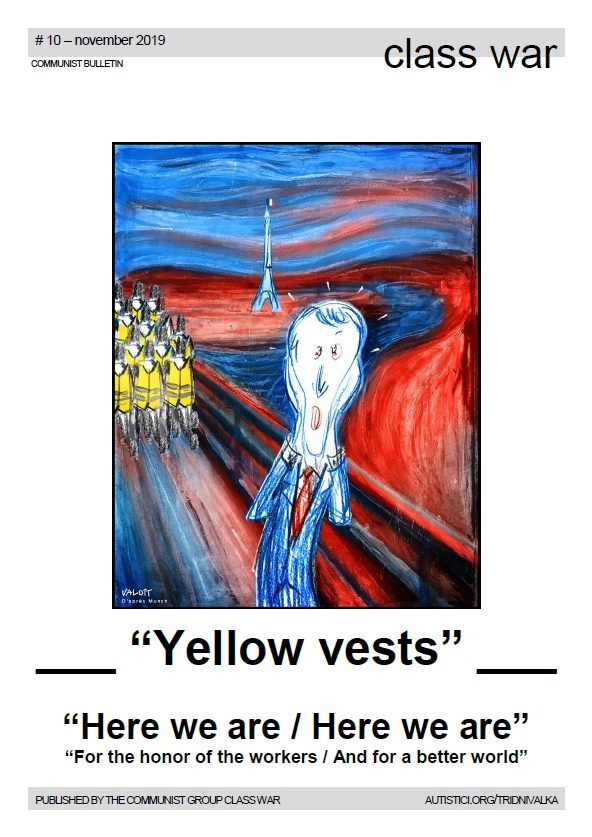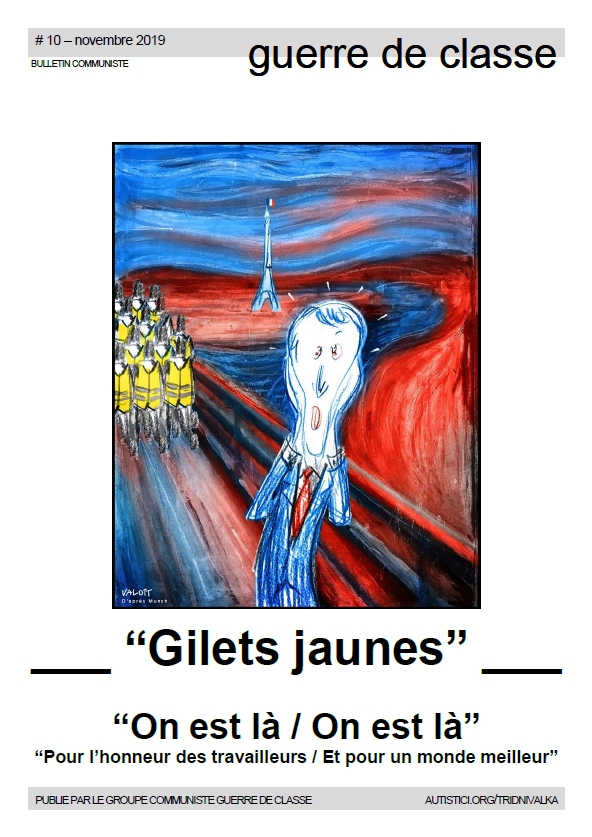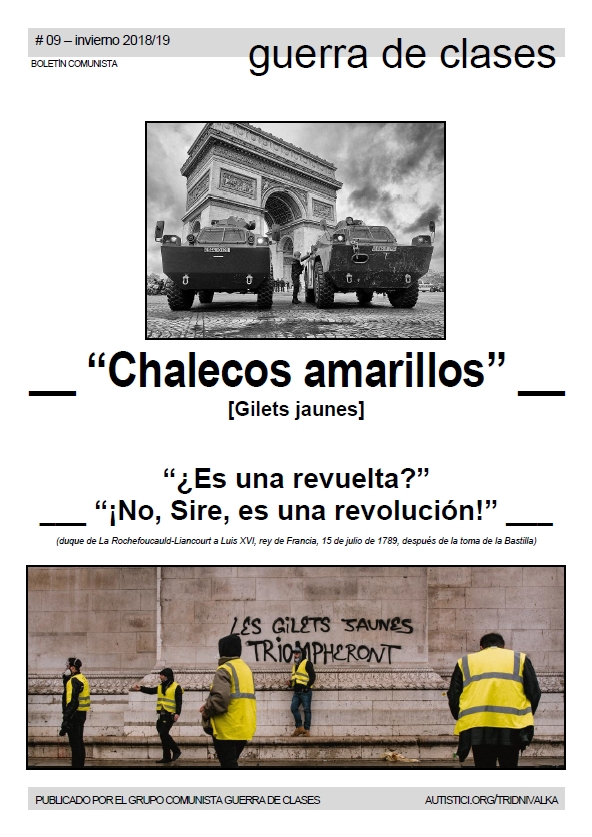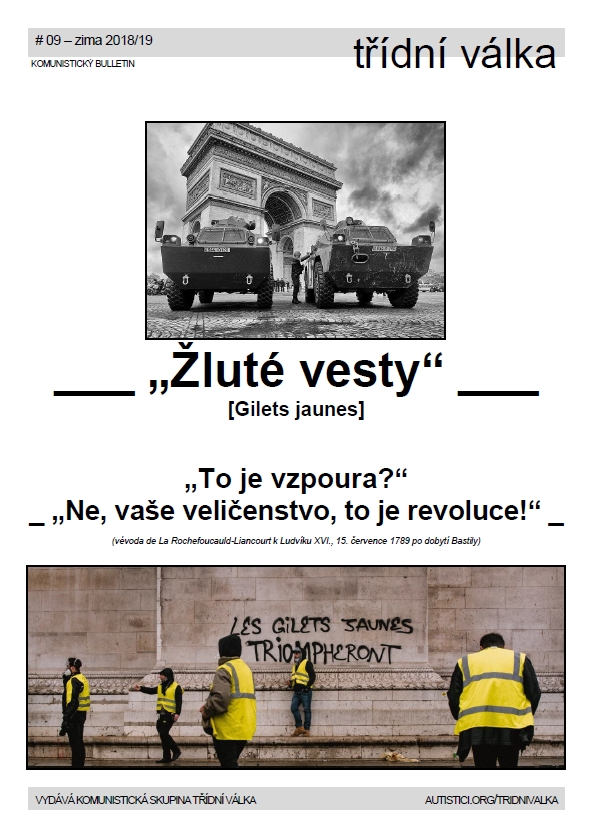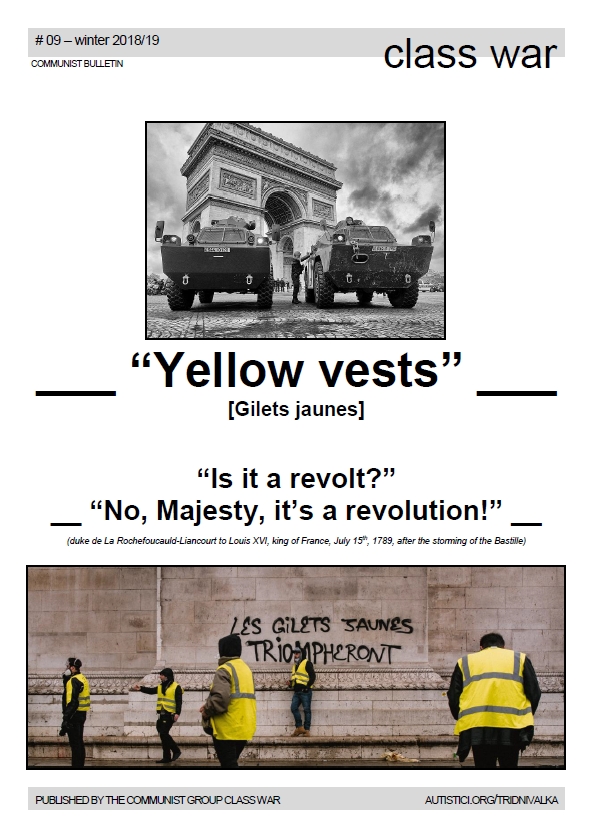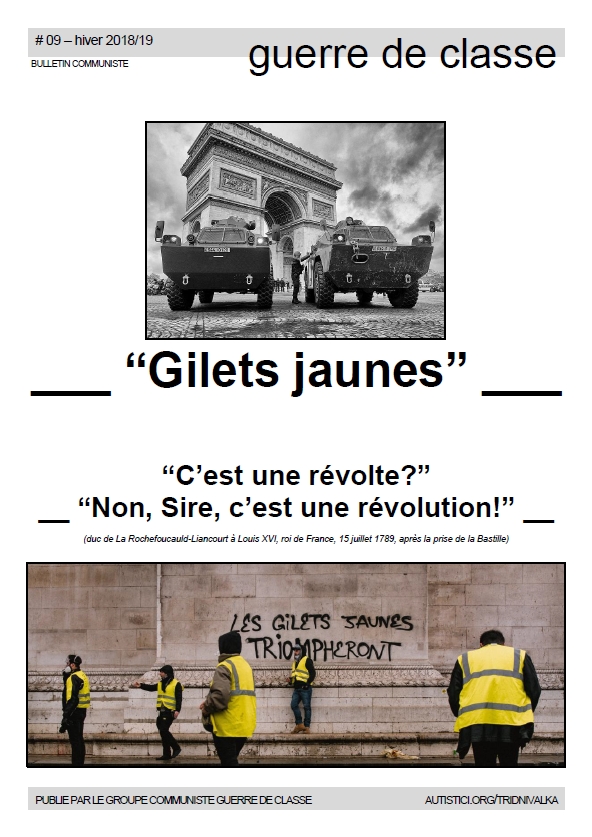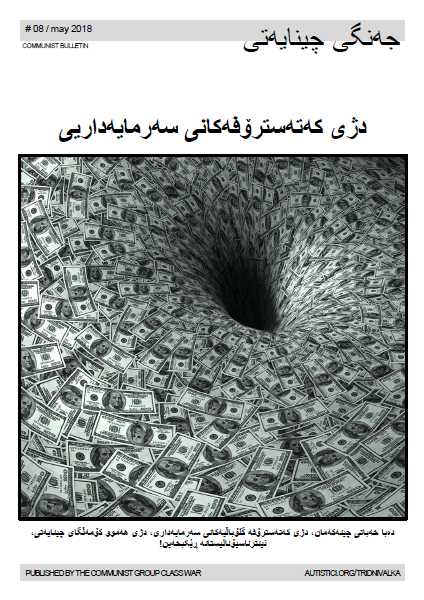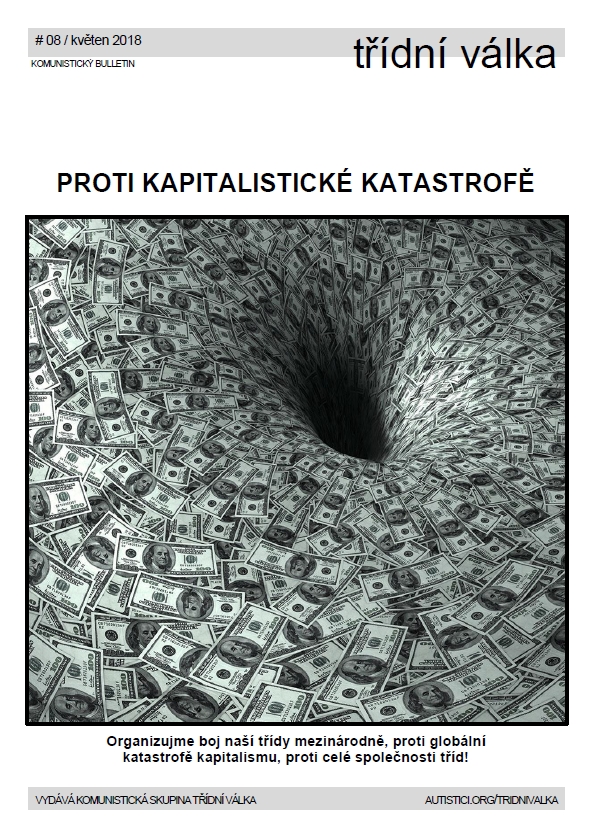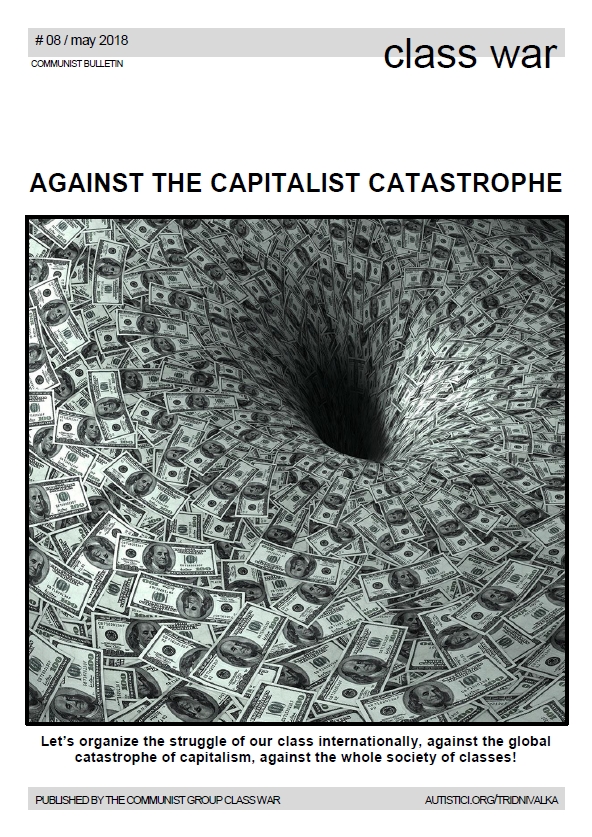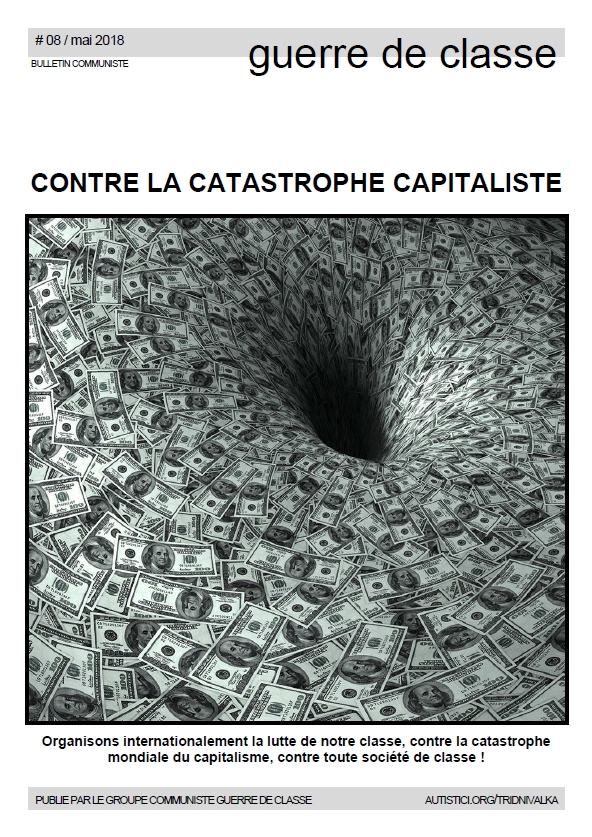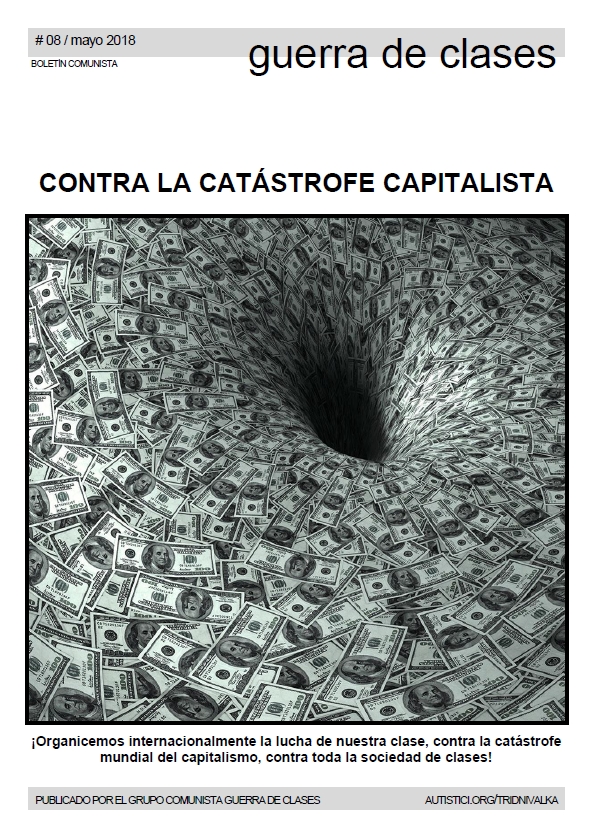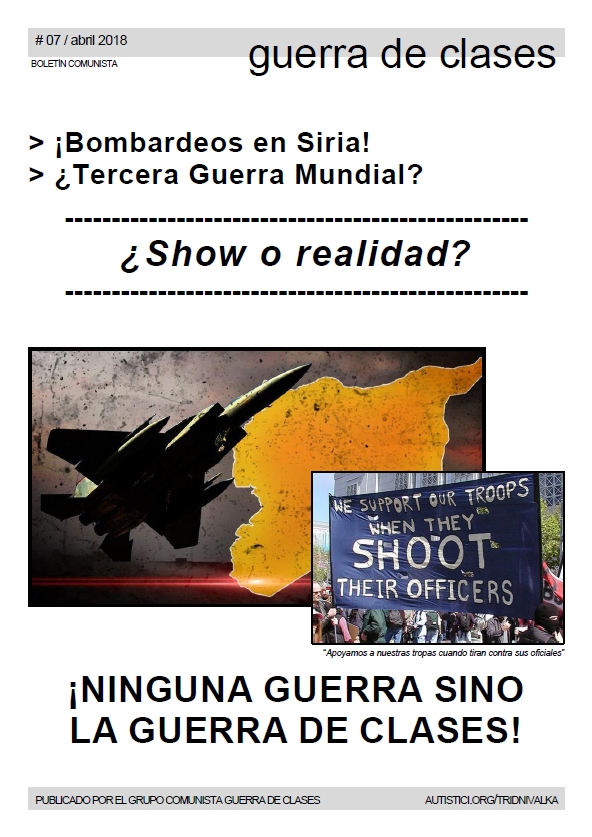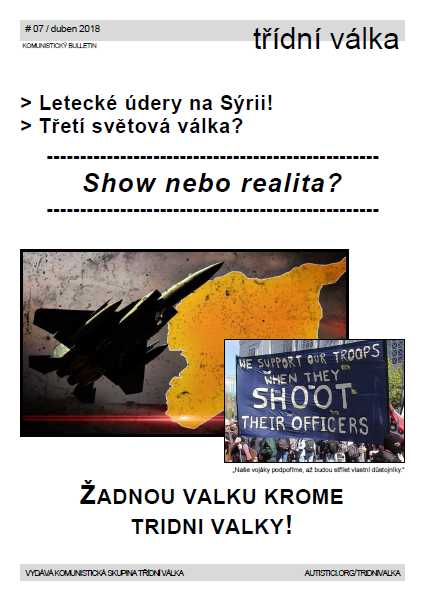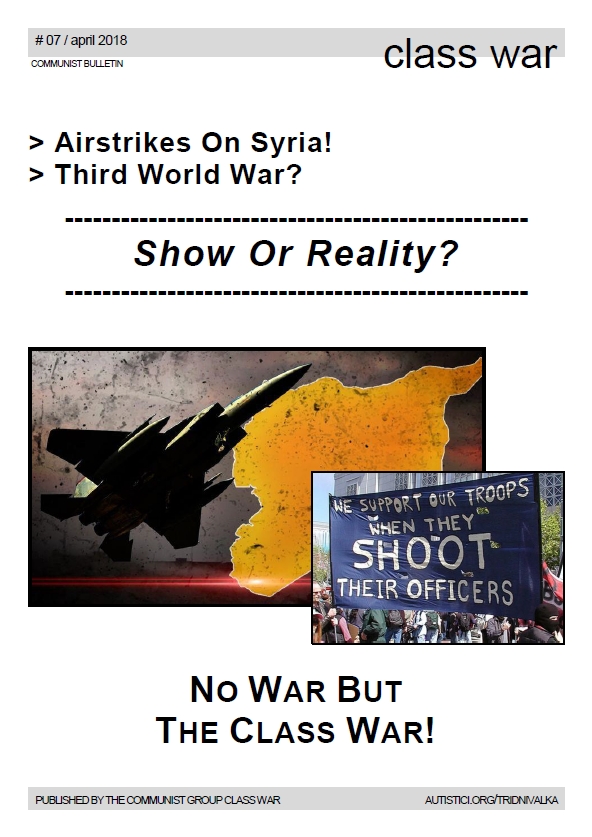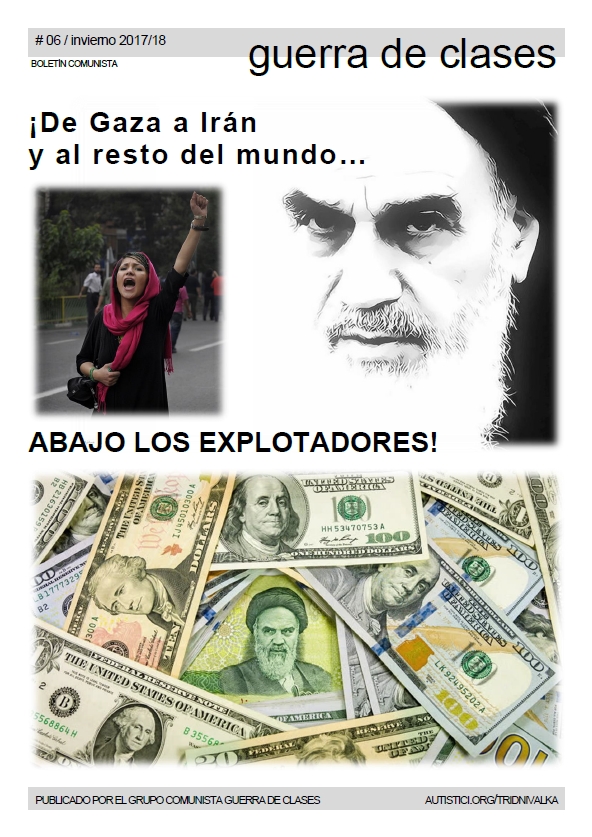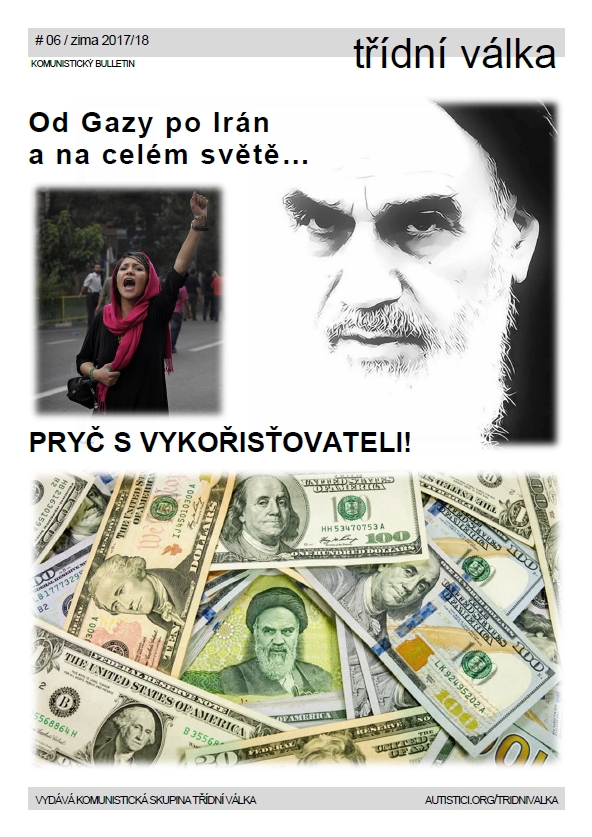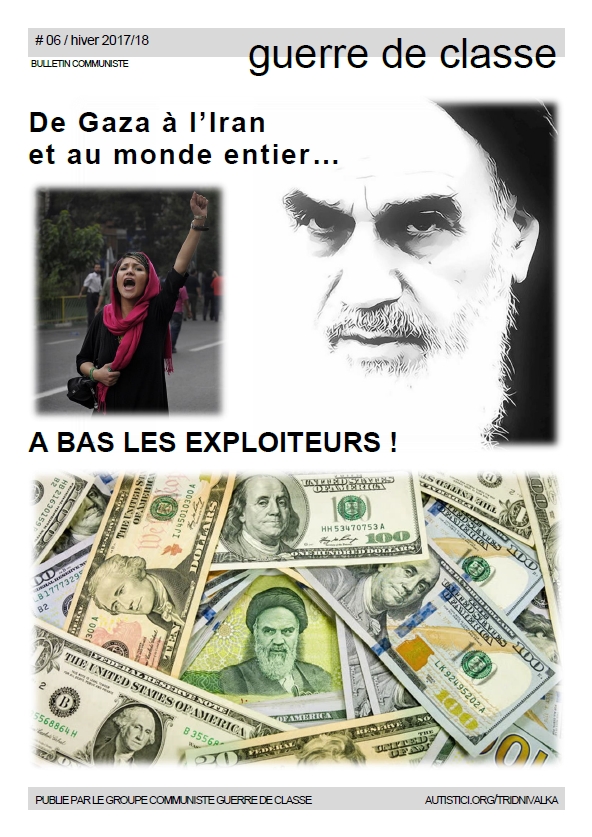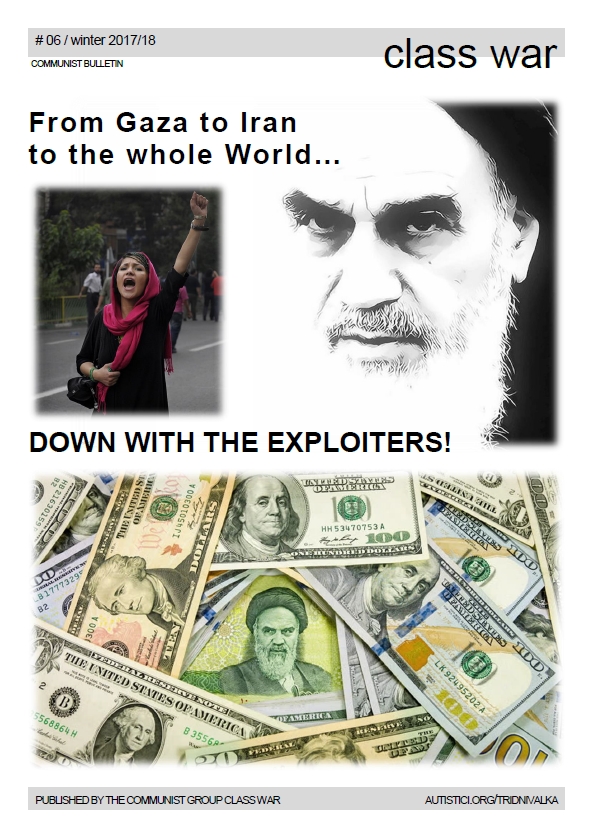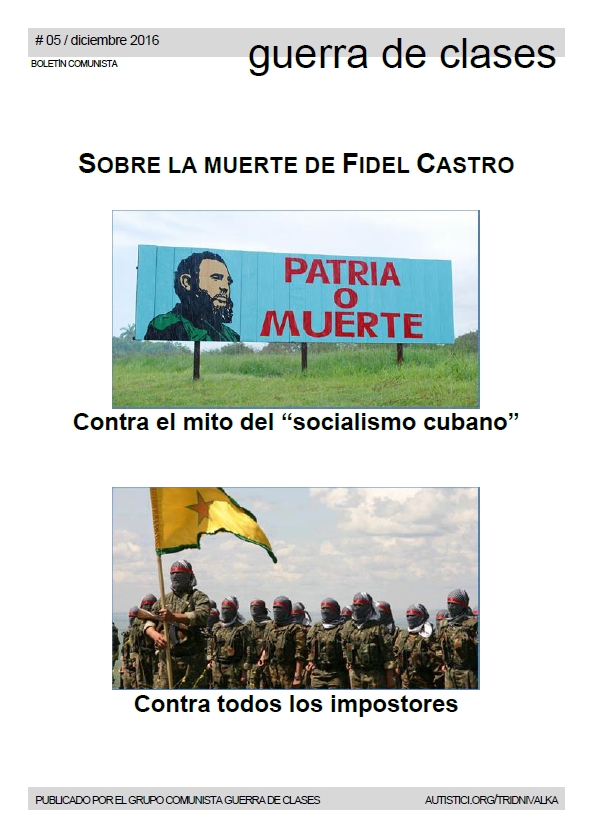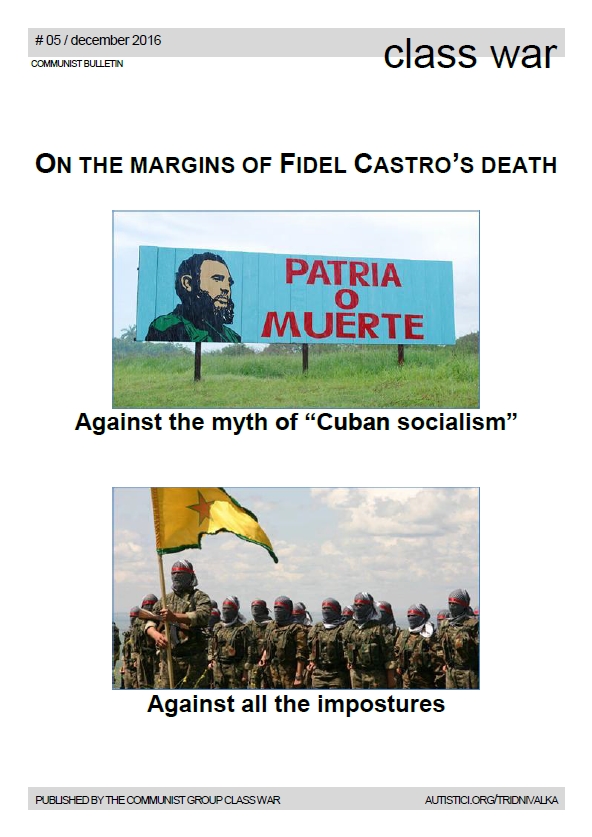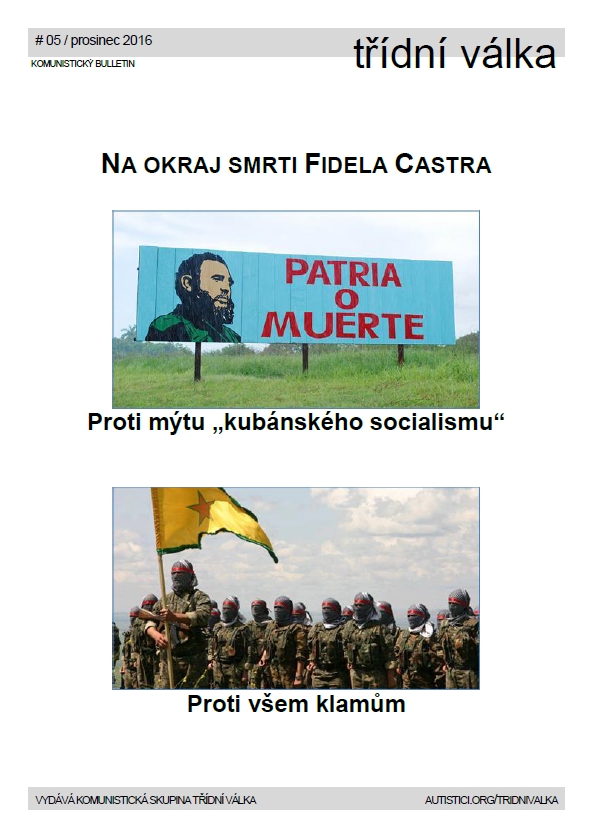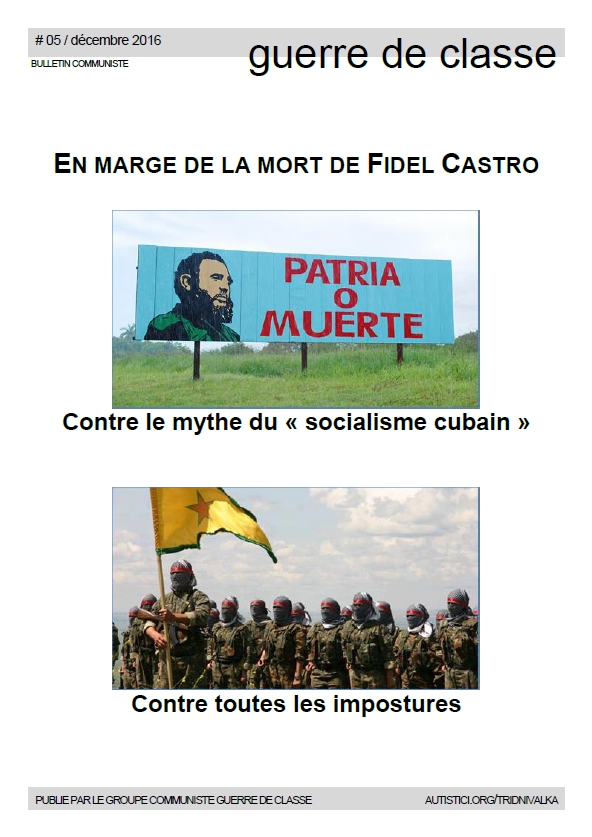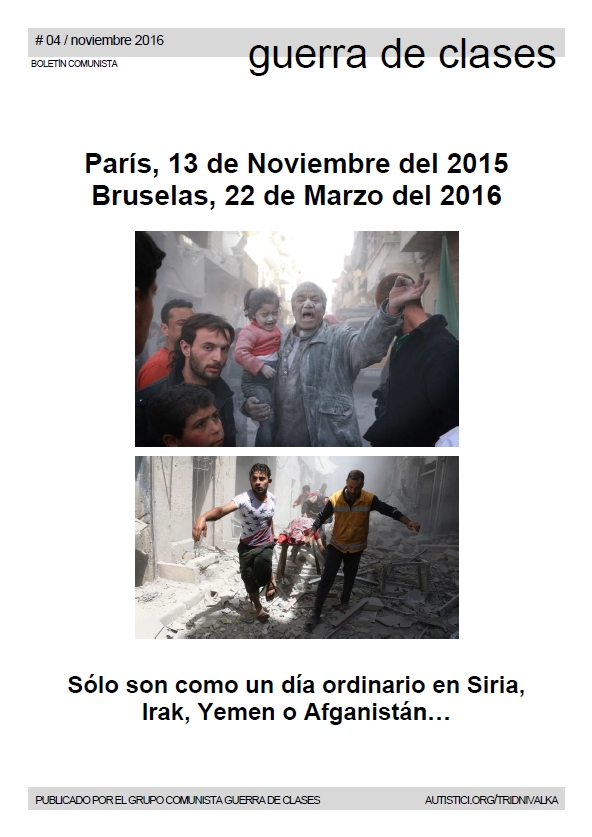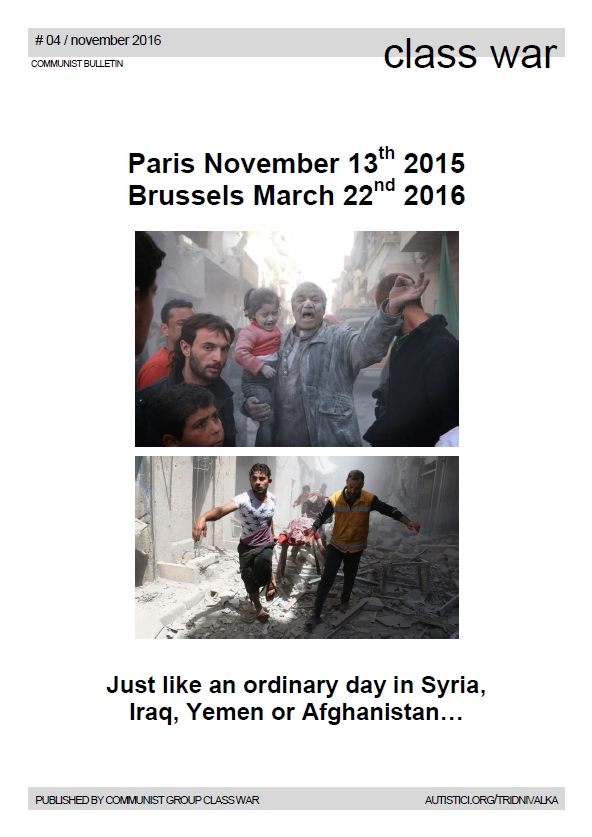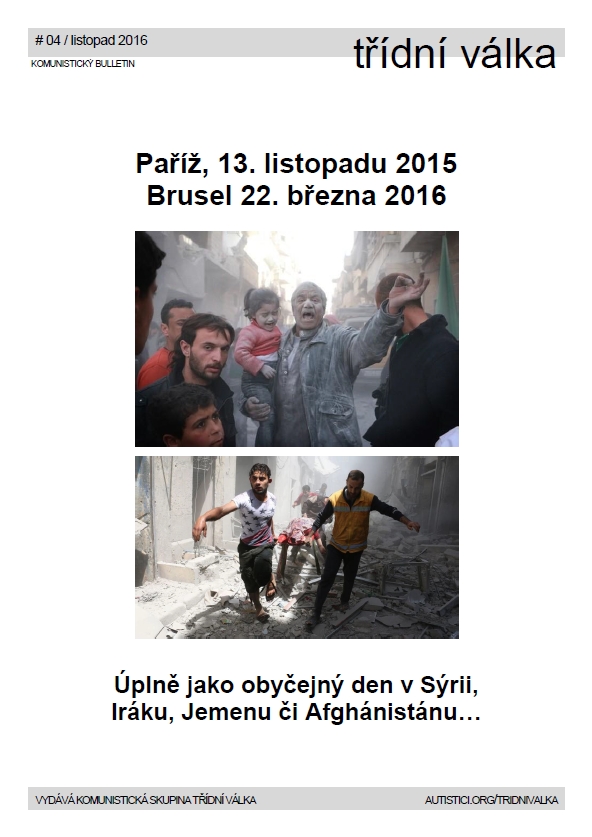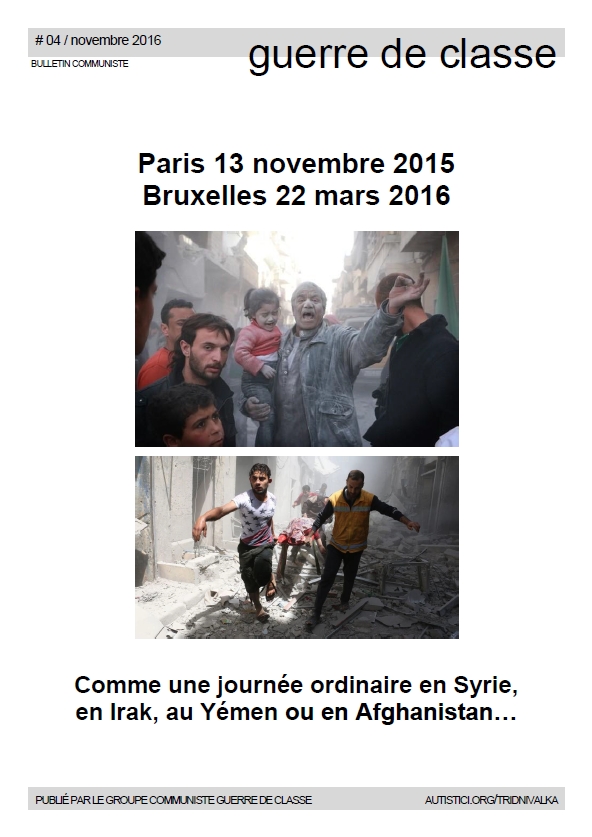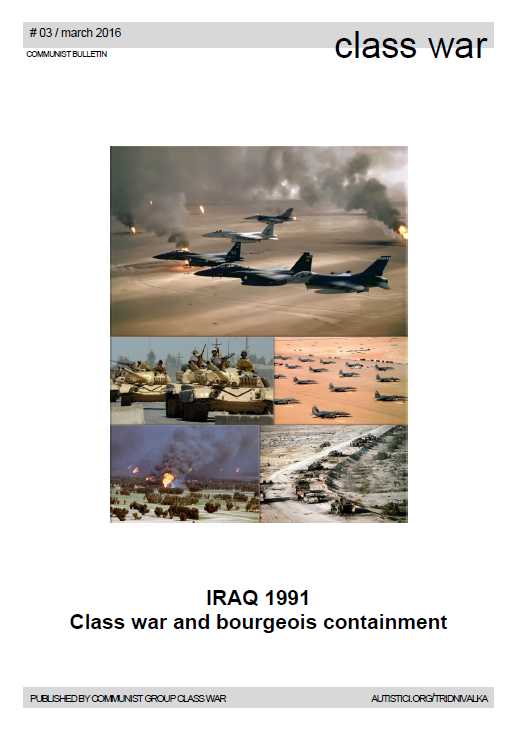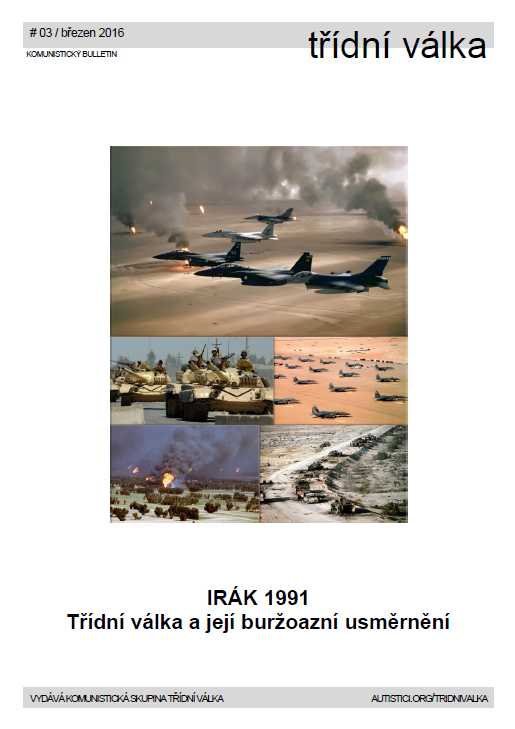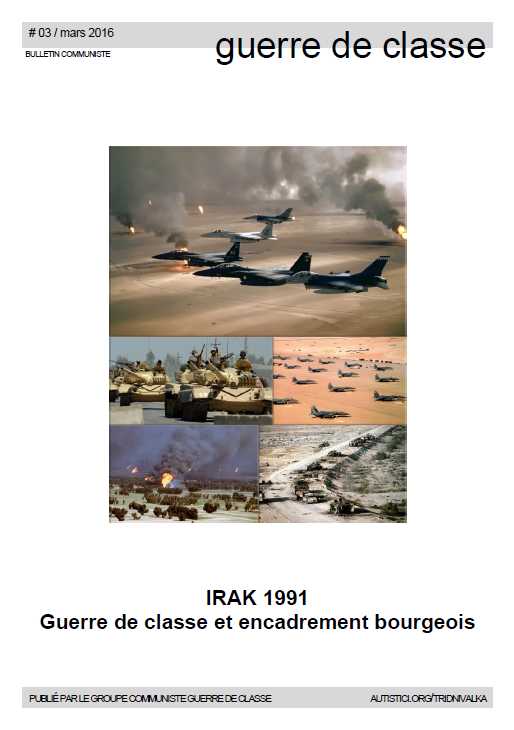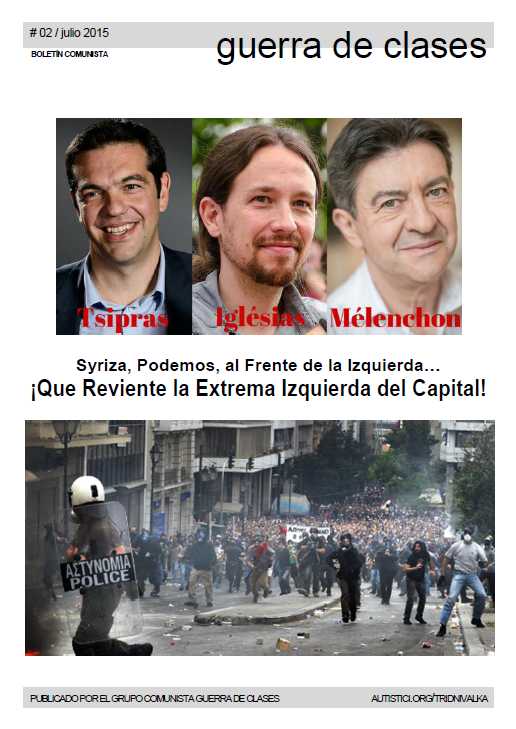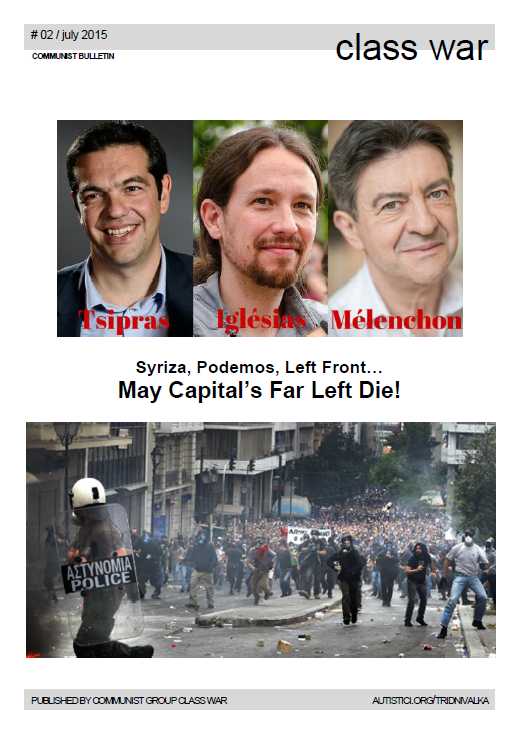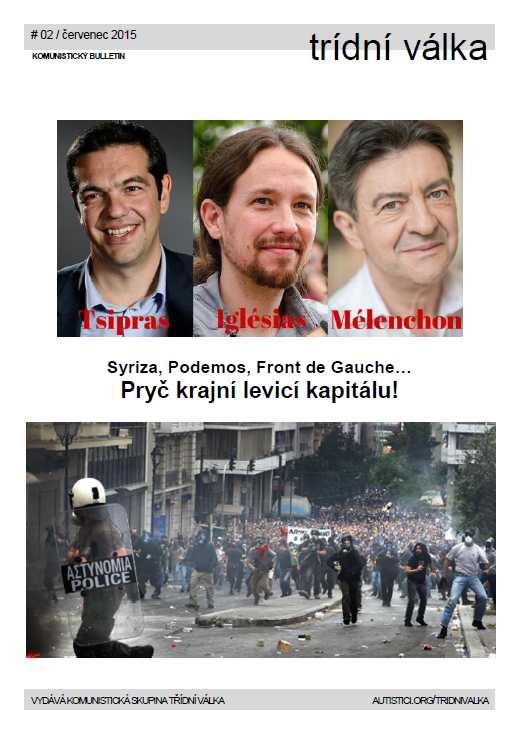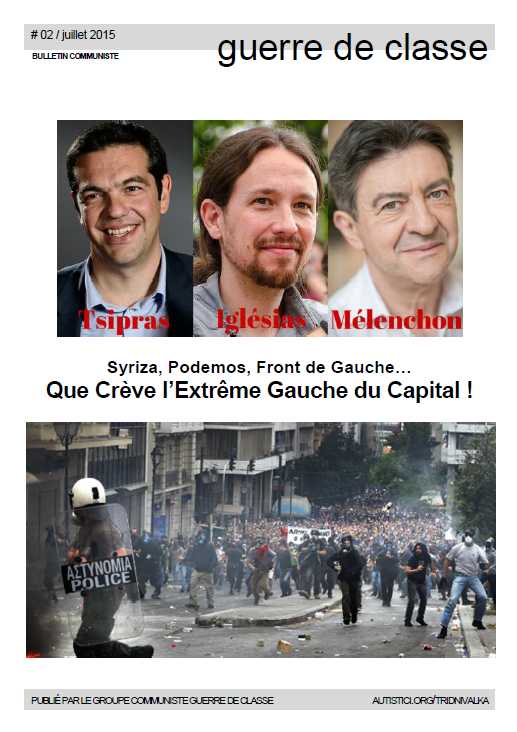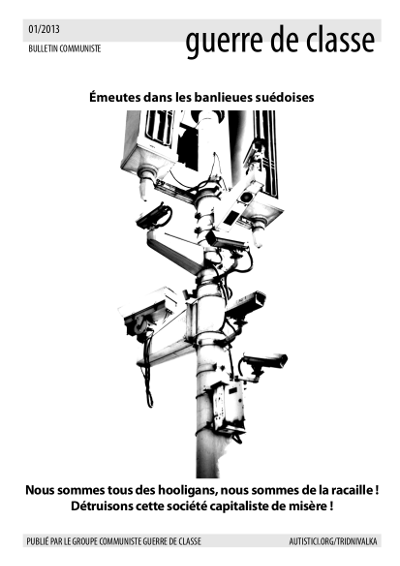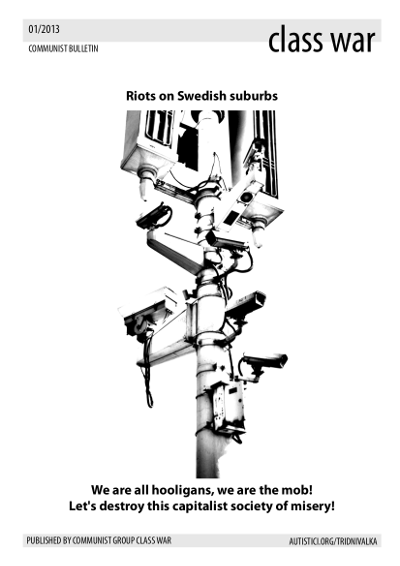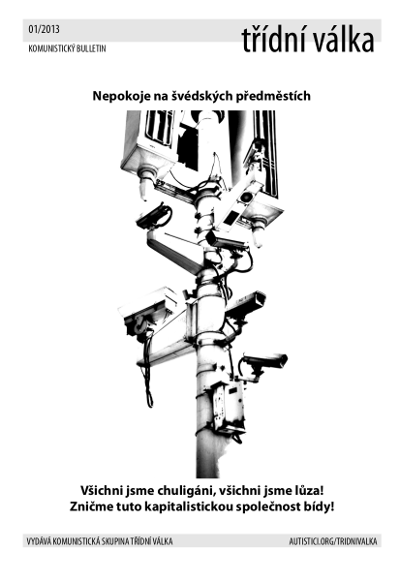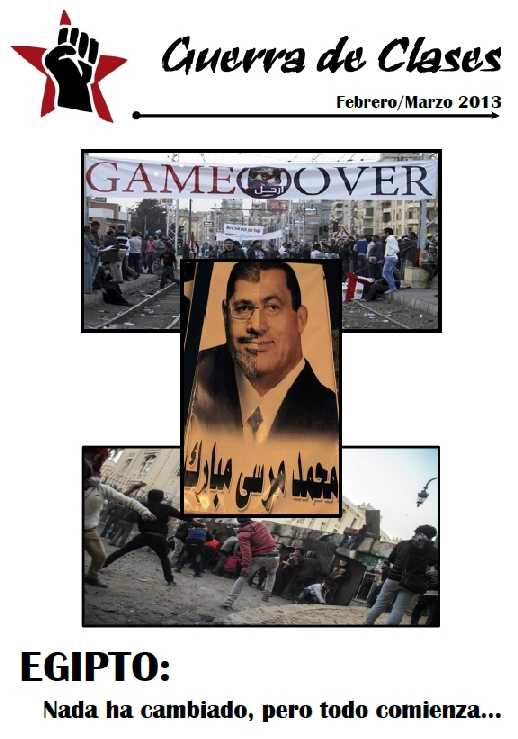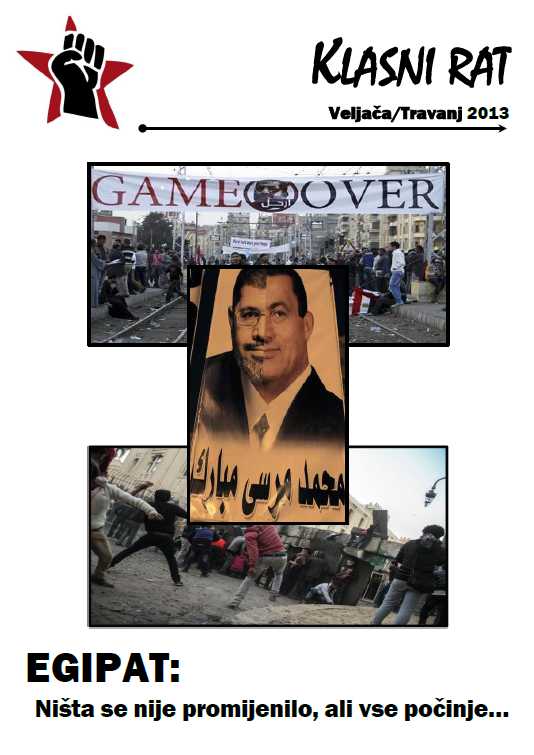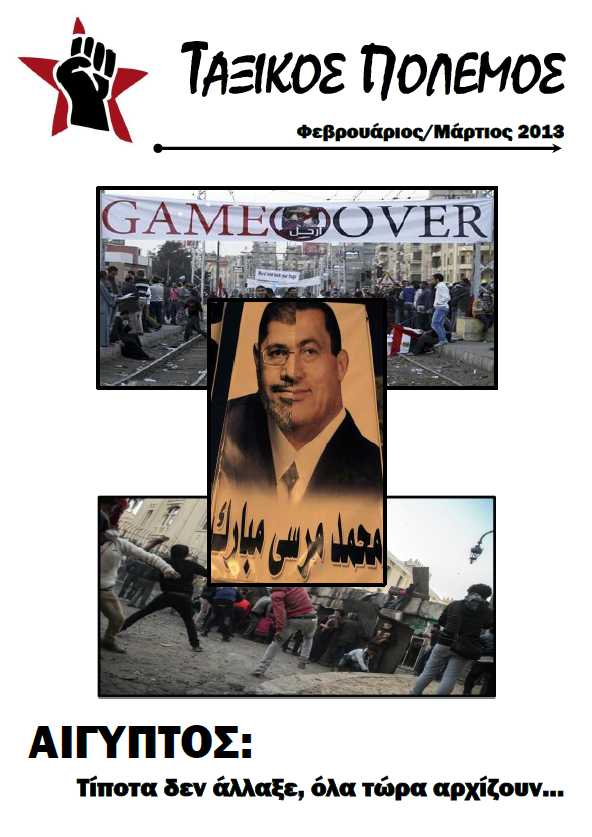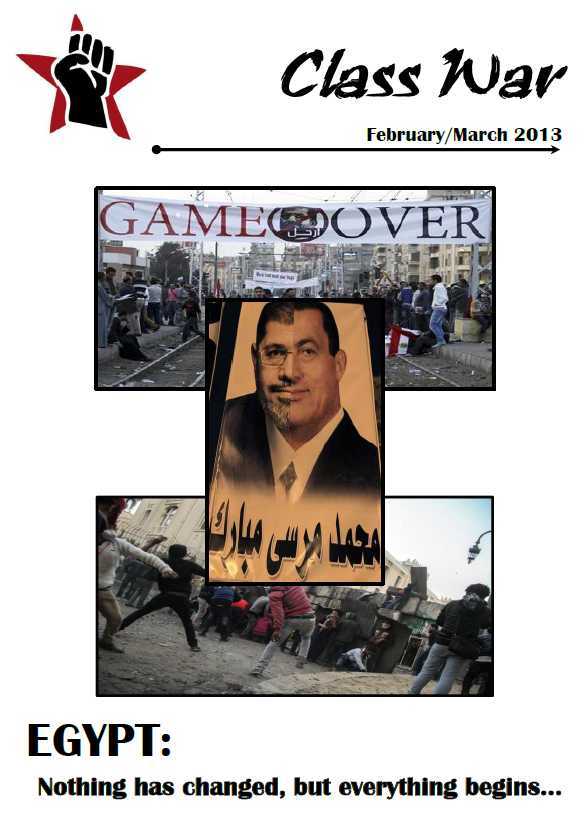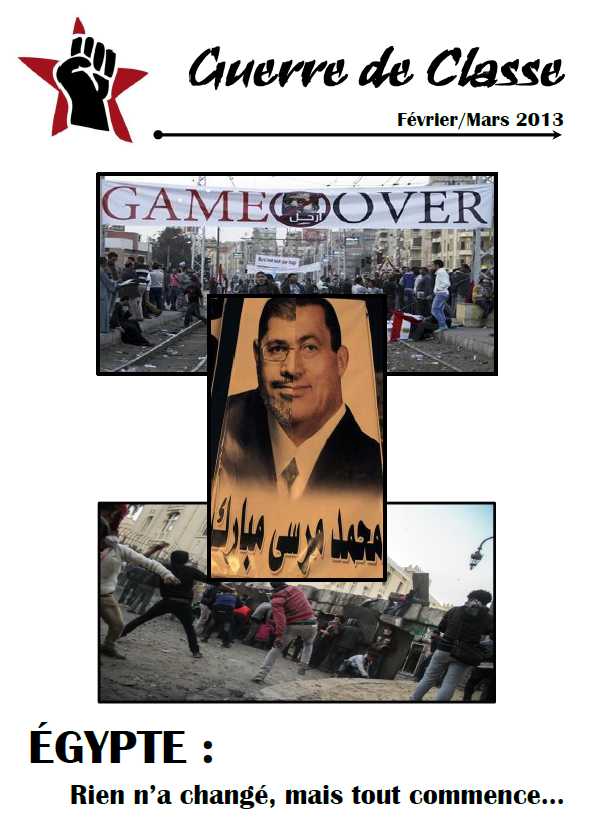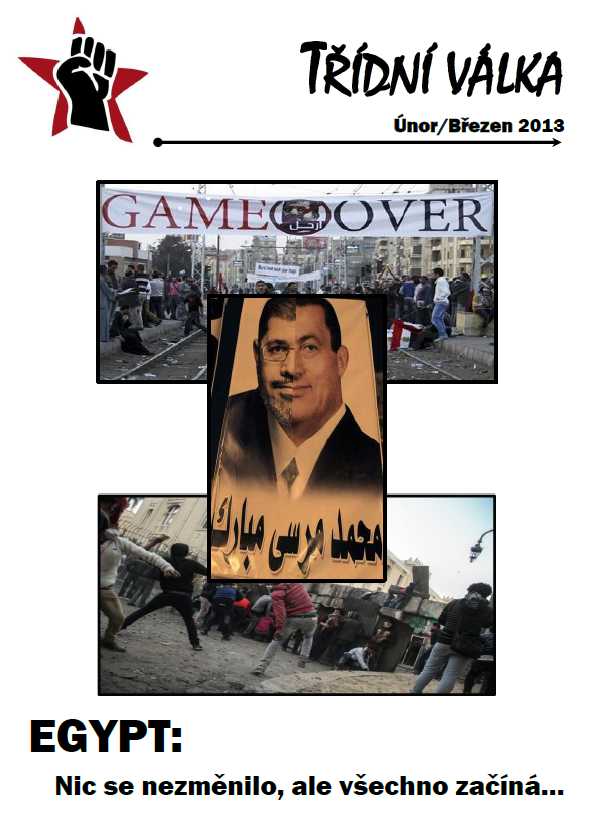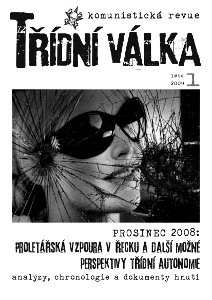| English | Français | Čeština | Español | Deutsch | PDF |
War & Revolution!?
It seems like yesterday when we finally left the “Covid-19 pandemic crisis” (although some say we will never leave it) and there is already a new “crisis”. According to the dominant bourgeois narrative the war in Ukraine is a new reason for the proletariat to put aside the satisfaction of their needs. Instead, we should join the united front with the forces of “our” bourgeoisie and sacrifice ourselves for a “greater good” of either “defense of territorial integrity of Ukraine” or its “denazification” – depending on where we live.
They force us to become the cannon fodder in “the defense of the nation”, which means to suffer and die for the interests of one or another bourgeois camp – as it is now happening to the “Russian” and “Ukrainian” proletarians. Or they force us to make sacrifices on the “home front” – to accept the increase in prices of basic commodities that allow our day-to-day survival like food, housing, health, energy, transport, etc.; to accept increased repression and surveillance; to accept militarization of work and brutal increase in the rate of our exploitation.
The war is of course an integral part of the very logic in which capitalism operates. It is an expression of a need of competing factions of the Capital to conquer each other’s markets in order to realize their profit. In this sense the capitalist war and the capitalist peace are just two faces of the same coin and any war is just a continuation of this competition by military means.
The 2022 war in Ukraine (which is rather a new open phase of the war that started in 2014) is no exception. In the last several decades they dragged us into other incredibly bloody wars, some of which are still raging on – in Somalia, in ex-Yugoslavia, in Afghanistan, in Iraq, in African Great Lakes region, in Caucasus region, in Syria, in Yemen… or recently in Ethiopia… All of those conflicts were born from the competition between local bourgeois factions, but at the same time represented turf wars in proxy between “the great powers” and in all of them (as always) it was proletarians who got slaughtered.
Despite being just as brutal as the war currently raging in Ukraine is, these wars did not allow the bourgeoisie to mobilize the proletariat in support of the capitalist interests on such a global level. The main reason is that this time the formation of the capitalist super-blocks capable of a global confrontation is much closer and the clash of their opposing factional interests is much more obvious and direct. Therefore, it is easy for the bourgeois ideologues on both sides to pretend that it is “a Holy war” of “Good vs. Evil”. Yet again they push us towards the killing fields in the name of peace, this time towards the war that can end all life on this planet.
Faced with the reality of mobilization, militarization of our lives, nationalist propaganda and horrible carnage of proletarians, the communist position has always been the revolutionary defeatist rejection of both camps of the bourgeois conflict in favor of the “third camp”, camp of the global communist revolution! We have addressed this recently in our leaflet: Proletarians in Russia and in Ukraine! On production front and military front… Comrades! as well as in a second contribution: Internationalist Manifesto against capitalist war and peace in Ukraine (both texts can be found in the appendices of this bulletin).
Similarly to the “Covid-19 crisis”, we as communists reject all bourgeois falsifications of the reality as they all serve the same purpose to keep our class subjugated to the interests of the ruling class and to prevent it from realization of its own class interests – i.e. to abolish the society based on exploitation of the human labor. Whether the narrative they try to impose on us is based on official “sacred” science and medicine (pretending to be objective and impartial) and government statistics or on “dissident and banned” science that “New World Order does not want you to see” (yet somehow it is all over YouTube), our only response to this is to re-affirm the position of militant proletarian subjectivity – i.e. to always analyze the material reality based on the criteria of what advances or hinders the struggle for our class interests. And from this position, and in confrontation with all the above-mentioned falsifications, we try to always uncover the proletarian current in all this turmoil.
Just like the previous “Covid-19 crisis”, the war in Ukraine is also claimed to be at the root of the apparent “economic crisis” and as a justification for scarcity and/or rising prices of many basic commodities. In reality, both these crises simply unmasked the underlying crisis of valorization.
There is not such a thing on this planet as a scarcity of food or energy. It is the logic of capital what creates the “scarcity” as the only reason why the commodities are produced in capitalism is to sell them in order to realize profit. Their use value as food, clothes, fuel, etc. has meaning for Capital only as a mean to this end. It is therefore logical to let the food rot away or burn the fuel rather than to give it to those who are unable to pay for it. Wheat from Ukraine or Russia will therefore not be transported via other routes or replaced by wheat or other edible product from elsewhere to feed the hungry proletarians in Egypt or Lebanon or Sri Lanka unless it can be made profitable.
In the following pages we attempt to analyze the proletarian movements that have been shaking the world despite the Covid-19 and the related lock-downs and the war in Ukraine, against the misery of life in the capitalist society and in opposition to State’s inter-class mobilization efforts. This text is neither supposed to be a chronology of these proletarian movements nor an exhaustive detailed account of day-to-day militant and organizational activity “on the ground”. There are other militants, with more direct connection to these movements than we have, who have assumed these tasks well. We focus on movements that according to us represent the peak of the recent proletarian militancy, while also keeping the militant continuity, reappearing in other form after they had been repressed by the State, giving birth to militant minorities or energizing the existing ones and potentially creating the space for the programmatic ruptures.
Let’s mention here that we plan to cover the revolutionary defeatist actions of the proletariat in the territory of Russia and Ukraine against the capitalist war (desertions and mutinies on both sides, attacks on recruitment centers, sabotage of war efforts, subversion of the recent mobilization in Russia, etc.) in a separate material. We also have to mention here January riots in Kazakhstan triggered by the high fuel prices, although we don’t talk about it in detail in the following text. It was a very strong eruption of proletarian anger and contained some insurrectional moments which led the local bourgeoisie to call for reinforcements from Russia and other CTSO (Collective Security Treaty Organization) countries to crush it and prevent it to develop into a full-scale proletarian insurrection. We have published on our blog a collection of militant materials from various groups reporting on the movement in Kazakhstan.
Sometimes everything has to change so that all stays the same…
The global ruling class had surely hoped to manage to mask the emerging structural crisis of Capital by turning a generalized “health crisis” (diseases, junk food, poisoning and destruction of the planet, etc.) through all repressive, recuperative and ideologically-spectacular means into a pandemic of Covid-19 – itself a product of exploitative relation of the society with the natural world stemming from the equally exploitative capitalist mode of production (just like all other “natural disasters” before). It had surely hoped as well that it will serve as a lid on the boiling cauldron of the proletarian class struggle that was raging in many parts of the world in 2019. A strategy that had at first seemed to be more or less successful, but soon it became clear that it turned it instead into a pressure-cooker.
Enforced curfew served from the beginning as an excuse for the repressive forces of the State to re-establish or confirm and strengthen both their social control over the proletariat and their monopoly of violence – sordidly and shamefully justified as “protecting the public” by propaganda. It came in different forms – public boasting of violence against anyone who dared not to respect the curfew (including for example shooting and killing kids for supporting the street demonstration from their balcony in Kenya), execution of long planned attack on squats and social centers in Germany, Italy, Greece, etc., clearing of proletarian neighborhoods to make way for developers in Philippines, South Africa, Haiti…, perfecting the means of electronic spying (Covid-19 Tracker software used by cops to track the protesters in Minneapolis, update to face-recognition software to see through masks).
At the same time, it was apparent that all this repression was only tangentially related to any effort to curb the spread of the Covid-19 disease. As far as Capital is concerned, a human being has no other value than the value of its labor force and the fact of workers getting sick with dangerous disease constitutes a problem only when it can negatively affect production of commodities. Therefore, while most of the government of national States tried to avoid uncontrolled spread of Covid-19 (sometimes as opposed to “controlled” spread limited to “inconvenient populations” – with any sanitary help deliberately rendered inadequate and/or sabotaged by State for inhabitants of favelas, quilombos and native reserves in Brazil, “Palestinian Territories”, refugee camps in Greece… and many prisons all around the world), death or permanent damage to health of the proletarians came very cheap (costing them only few crocodile tears shed in the bourgeois media). Needless to say that even during the strictest lock-downs, most of the proletarians globally were still obliged to work and commute without any meaningful measures to protect themselves.
Deeper we enter into this “Covid/post-Covid era” more and more it becomes obvious how false the dichotomy between “security” and “freedom”, that bourgeois forces are imposing on us is – and in fact it is nothing more than a thin veneer to hide what has always been the sole directive that all bourgeois factions in history had for the proletariat: “Work! Consume! Obey! Sacrifice!”
During more than two years the worldwide struggling movement of our class was taking place in very specific circumstances. Though none of this is unique in a human prehistory – pandemics, curfews, crises, wars… – it all was here before. The revolutionary wave of 1917-1921 has taken part in the context of (apart from “the First World War” obviously) “the Spanish Flu” pandemic. There is not much militant material from that time dealing specifically with the question of disease itself – only some fragments like demands of the striking workers in Spain to be fed better and to work less as a measure to improve their immunity or the mentions about the role of flu in delaying the departure of Wilhelmshaven fleet, contributing to the material conditions for the mutiny to erupt. Revolutionaries of the time correctly took the disease as a part of the whole miserable existence in the capitalist society against which they rebelled. It is important to stress that it is the totality of capitalism – a global class society based on the exploitation of human labor – that communist movement opposes and struggles to overcome, destroy and abolish. The horrible reality that we live through – disease, war, poverty, violence, alienation, oppression, hunger, discrimination, ecological catastrophe, etc. – is the inevitable product of the operation of Capital. But we cannot limit our critique only to these negative expressions of capitalism, as it opens the door to the reformist framing and channeling of our struggle into the movement for “reformed capitalism”, “capitalism with a human face”, “more democratic capitalism”, “self-managed capitalism”, “green capitalism”, “non-racial capitalism”, etc. – all of which are just social-democratic projects trying to keep the system of exploitation ongoing with a different facade.
In this way we have also to approach a particular expression of the proletarian movement, which exploded all around the world (France, Italy, Australia, the Netherlands, USA, Romania, UK, Israel… to list just a few) – of what bourgeois media call “anti-Green Pass” movement (or its regional equivalents).
We will not play here a tune of its bourgeois detractors identifying the whole movement with its most reactionary, reductionist, democratic or single-issue current, disorganizational tendency of individual liberties! On the contrary, through all its contradictions we want to put forward and support its most advanced and class-conscious current as an expression of the global proletarian class movement, in continuity with the “pre-Covid” wave of struggles, in continuity with struggles against capitalist misery in USA, Lebanon, Iran, Colombia, Iraq, Haiti, Burma, Cuba, etc. We recognize and claim the targets of this current – repressive forces, State institutions, corporate headquarters, “medical-industrial complex”, banks, etc. – as points of capitalist infrastructure that historically always have been attacked by the communist movement! We also support methods taken by it belonging to our class arsenal – strikes, blockades of arteries of capital (in Trieste…), expropriation of commodities as the methods of our struggling class against the logic of capitalist accumulation of value!
We see “Green Pass” (or some of its alternatives outside of EU) – that has become symbolic enemy of this movement – as a contribution to the arsenal of the capitalist State used for controlling, spying on, categorizing, dividing, disciplining, alienating, marginalizing the proletarians. In its prevalent form which is the electronic one it adds another tracking functionality to the portable spying machines (the smart phones) that so many are willingly carrying around and that already constantly send your physical coordinates to the operator, store your calls, messages and files on its servers, that can be remotely updated to listen to you via microphone, to turn on your camera, install face, voice or fingerprint recognition software, software “sniffing” the identity of and traffic going from and to other devices connected to the same Wi-Fi as yours, etc. We also see “Green Pass” as another ideological justification, “sanitary” this time, for strengthening of “Fortress Europe” (or US, UK, Israel, etc.). Yet another racist argument to reject those “unwashed and non-vaccinated migrants” or keep sealed that border with “a hostile neighbor”. Obviously, proletarians living in the most crushing conditions – undocumented migrants, homeless and other “criminals” – who are less likely to get a vaccine for fear of being brutalized, arrested or deported by pigs – will now be even more marginalized. In Italy, where “Green Pass” had for several months been a requirement for the employment, it was used by the bourgeoisie as an excuse to fire the workers they already wanted to fire or to lock-out the production (due to a lack of components for example) without paying the compensations. Last but not least, “Green Pass” was an experiment with the institutionalized nationwide division tactic and “carrot and stick” tool, as a “Western” response to “social credit system” in China.
With all the critique towards the “Green Pass” that we have just expressed, we want to say, that we spit in the face of the social-democratic scum trying to portray the “Green Pass” as an issue apart from the rest of the bourgeois State tools of control over the proletariat (physical, social, legal, digital, etc.) and from the rest of the miserable existence in this society, in order to once again channel the class movement into some sort of call for a reform of the capitalism! All those who were trying to convince us that we should struggle just for the return to pre-Covid normality, that we should be content with pre-Covid “business as usual” framework of exploitative relations, that we should stop at opposing “Green Pass apartheid” and we should not challenge separations between “nations”, “races”, “genders”, “economic sectors”, etc. Bourgeois democratic current (in its “fascist” or “liberal” mutation) was trying to frame the whole question of “Green Pass” and/or vaccines as an issue of “personal choice” or “personal liberty” and through this, in tandem with State ideologues of individual responsibility for stopping the disease, they were trying to uphold the atomization of the proletarians, to lock them in their little personal bubbles and to counteract the emerging process of proletarian associationism.
Just like “Yellow Vests” movement, this “anti-Green Pass” movement was ripe with contradictions which could only be overcome through the process of practical and programmatical (which are inseparable) rupture with its limited one issue scope – process that most advanced currents inside the movement were pushing for. Militant links have been forged with movements against expanding methods of State control, police brutality, worsening of working conditions and firing workers under the disguise of anti-Covid-19 measures, digitalization of workplaces and society, victimization of undocumented migrants, non-payment of promised bonuses to nurses and doctors, etc.
We cannot predict whether in the coming months the Covid-19 pandemic (which had almost completely disappeared as if by magic the day after the Russian army entered Ukraine, except maybe in China where massive lockdowns and repression are still very strong) will continue around the world, as will the global State vaccination campaign in one form or another. But what we are almost certain of is that on the one hand the State will continue to hold the pandemic card in reserve, and use it if and when necessary, and on the other hand digitalization of society and adoption of remote working will continue to spread and accelerate. Also, the bourgeois attempt to make us pay “the cost of pandemic” will be reinforced all over the world, not to mention the astronomical costs of the war in Ukraine and the economic and social crisis that, although pre-existing to the latter, is developing exponentially in parallel, and for which our class will be very quickly and in fact is already called upon to “pay the bill”. Because the war in Ukraine is going to continue as both opposing bourgeois camps are mobilizing indeed more and more resources (both the “canons” and their fodder) to continue this slaughter, the oscillation of the prices of hydrocarbons brings for its part additional element of instability.
But let’s come now to the analysis of the various movements of our class that have emerged in the last two years around the world, both in the Covid sphere and under the diktat of the “new paradigm” of the war in Ukraine and its direct consequences…
We will not pay for your crisis!
The year 2019 brought an extraordinary upsurge of the class struggle worldwide – from Santiago to Paris (and to Tehran and Baghdad and Beirut and Hong-Kong) the proletarian revolt erupted against the gangrene of capitalism. Massive protests, riots, strikes, looting… attacks on the seats and symbols of State power, as well as its infrastructure… And in limited and embryonic way, attempts of some militant minorities to go further – to formulate and organize the concrete realization of the historical tasks of proletarian insurrection:
- grasping the question of arming of the proletariat,
- calling for and practically organizing acts of revolutionary defeatism,
- attempts to centralize the publication of revolutionary propaganda,
- agitation in the ranks of military and police forces,
- attempts to centralize with revolutionary militants worldwide.
In many regions of the world, with “Latin America” and “Middle East” regions as its spear-heads, proletarian movement was shaking the bourgeois social order despite all the “traditional” methods of historical social democracy (regardless of its political belonging) – like elections, trade unions, calls for reforms and referendums, calls for patriotic unity, etc. – to pacify it. Of course, the weaknesses of our class like the internalized bourgeois vision of the world with its borders and nations and political parties and religions were hard to overcome and were readily built on and exploited by our enemies in order to again channel the rage of our class into some reformist project. But it never took long before the contradictions inherent to the capitalist society gave birth to another rupture, deeper than the previous.
When the year 2020 (and Covid-19 pandemic) came – it added new weapons to the bourgeois arsenals of appeasement, control and repression.
False choice between obeying the “sanitary” repressive measures of the State and individualist, reformist and “pro-work” project of “anti-lockdown”, “anti-mask” and “anti-vax” activist were added to the plethora of pre-existing false choices for the proletariat.
However, the proletariat could not be contained for long – in many places all around the world (from which we will put forward here Lebanon, and Colombia and Iran as the most confrontational examples), even in this “new era” streets were once again burning.
In fact, the pandemic had hardly any impact on the protest movement in Lebanon, where the full emergence of the already simmering crisis of Capital with all its immediate expressions like hyperinflation, rise in unemployment, failure of water and electricity distribution and food production, as well as the deadly explosion in Beirut port completely overshadowed the danger of Covid-19. It did not help the local bourgeoisie, that it was unable to even pretend to care about lost lives (be it to Covid-19, the Beirut port explosion, starvation, bullets of cops…). But even when it attempts to make through its media some appeasing noises, nobody listens anymore. Indeed, just as in USA (where another strong movement exploded despite the pandemic), the movement in Lebanon had to resolve by its own means the question of protecting itself from tear gas (some even reached out to comrades in USA and shared with them practical tips, for example on code-sharing website GitHub), from batons and bullets as well as from the infection. In the territory, where starving to death is a real danger, community kitchens are being organized cooking with (donated, but often also expropriated) food and distributing it in proletarian districts.
We would like to stress the importance that the task of liberating the process of food production and distribution from the capitalist dominance has for the development of class struggle, even more as it approaches insurrectional level of rupture with the class society. During the days of “business as usual” food is nothing but a commodity, produced just as any other commodity, only for its exchange value in order to realize the profit for the bourgeois. In time of social upheaval however, if food stays in the hands of our class enemies it gains another nasty role – it turns into a weapon of counterrevolution. We could see this unfold during the uprising in Iraq in 1991, when the Kurdish nationalist forces monopolized the food and subsequently used controlled starvation to crush the rebellion – by exchanging food rations for weapons, for denouncing the comrades, for dissolution of autonomous proletarian structures or their integration into the State.
We can see similar attempts in Lebanon for example from side of Hezbollah, which keeps and protects its network of warehouses full of basic goods like food, fuel, medicine and clothes. These stockpiles are originating from its own farms and factories, from UN “World Food Program”, smuggled from Assad’s controlled territory in Syria or donated by Iran. It is than selectively provided by Hezbollah social workers to a part of the “Shia population” as an appeasing method to discourage the proles from expropriating the commodities through self-organized militant action as well as to politically bind them to Hezbollah and to try to re-establish the sectarian separation that the movement of our class is radically subverting in daily practice as well as in its understanding of the reality stemming from it.
Traditional sectarian division that for decades had been part of all aspects of life in Lebanon is generally a target of critique and active resistance. Loyalists of all major parties (regardless if they are part of the government or the opposition) are being confronted by protesters in the streets. On the massive demonstration (that turned into riots, when repressive forces of the State started to shoot into crowd) following the explosion in Beirut port, the protesters build gallows on the main square with the photo cut-outs of president Michel Aoun, parliament speaker Nabih Berri, prime minister Hassan Diab, former prime minister Saad Hariri, Hezbollah secretary-general Hassan Nasrallah and president of the Progressive Socialist Party Walid Jumblatt. Similarly, buildings of many State institutions, including the parliament, several ministries and seats of political parties (Hezbollah included), but also private villas of the politicians and militia leaders are routinely targeted by angry rioters almost every time there is a demonstration and often there is a hesitation in the ranks of the soldiers, whether they should repress them – apparently there was a string of desertions from both Lebanese Army and Hezbollah Armed Forces.
This being said, we have to denounce the fact that bourgeois ideology in more “secular” forms of Lebanese nationalism (“anti-Syrian”, “anti-Israeli”, “anti-Palestinian”, “anti-Iranian”, etc.), liberalism, “europhilism”, Leninism etc. have considerable impact on the direction of the bulk of the movement. Only a minority of “Syrian” and “Palestinian” refugees, of which there is somewhere between 1.5 and 2 million living in Lebanon, took part in the movement as this expression of bourgeois social separation along the ethnic lines has barely been scratched by it. Only some minorities of militants of which existence and activity we have only fragments of evidence (like the famous “Revolution everywhere” chant that spread on the internet) are able to (at least partially) consciously rupture with the ideology of national popular revolution of “Lebanese people” and try to connect with the community of struggle elsewhere in the world.
Future will tell if these advanced minorities of proletarian movement in territory of Lebanon will be able to forge the links of practical solidarity, militant discussion, organizational centralization and revolutionary defeatist practice with minorities in other territories, particularly those of Iraq and Iran with whose it shares many of the underlying immediate material conditions, such as lack of basic necessities, brutal violence of sectarian militias and involvement in war in Syria.
More specifically, we can see the materialization of “East-West” axis of economical and geopolitical interests, between Hezbollah, Assad’s regime, “Shia” bourgeois faction of Iraq and “Revolutionary Guards” of Iran. Concrete expression of this is a clear goal of these factions (among other things) of linking the Persian Gulf with eastern Mediterranean with infrastructure projects (pipelines, roads, railways). This axis stands in opposition with the (for the moment much more fractured by discord in many local, particular interests) one of “North-South” running from Turkey, through the Iraqi Kurdish territories (and in a sense also territories under control of Islamist groups and Israel) to Saudi Arabia and Gulf States. These axes (along with few “wildcards” a la “Rojava” or “ISIS”) are in one way or another prompted by the “superpowers” – USA, Russia, EU, China… Of course, these alliances are internally contradictory and are not set in stone, as they are an expression of only temporary democratic unity – the only unity that bourgeois factions, constantly pushed into conflict by very logic of capitalist competition, can reach.
This concrete materialization of imperialist expansion inherent to every faction (“national”, “religious”, “partisan”, etc.) of Capital and the carnage and suffering it brings to the proletariat, has been denounced and practically attacked by the most advanced sectors of the class movement in the region of “Middle East”. Let us remind the clearly revolutionary defeatist motto at the peak of insurrectional movement in Iran of 2017/2018 “From Gaza to Iran, down with the exploiters!”
Movement that, after being crushed with almost unprecedented brutality by Iranian State, managed to regroup and explode again with the same intensity in 2019. Despite all the repression, pandemic and lock-down, despite all the democratic electoral farces, reforms, etc., streets of Iran are recurrently on fire!
In reality, this movement had not grown in isolation – there had never been a complete social peace in Iran since at least 2016! Literally hundreds of strikes, many of them wildcat and rejecting the trade union representation, are being battled all around Iran every week – in oil industry, steel industry, sugar production, agriculture, schools, hospitals, railways, public transport, taxi services, etc. along with street protests of pensioners and students and prison riots – all this going in a rolling fashion continuously since the beginning of 2020.
In February 2021, a series of riots broke out in Sistan and Baluchistan province over the massacre of “informal traders” protesting against closure of the border with Pakistan, which blocked their only source of income – selling “untaxed” fuel to Pakistan. This carnage, which left 37 dead and several injured and which was committed by “Revolutionary Guards” (apparently with a help of Pakistani border guards) started a week of unrest, where provincial government building had been stormed, several police stations conquered by an angry proletarian mob and had to be put down with bullets and information black-out.
The immediate spark of this wave of struggles was the lack of clean drinking water, mainly in Khuzestan province (where the protests started) and the rest of Southern Iran and the other immediate causes included also power outages, non-payments of wages and police harassment as well as general hate and disgust towards the State (even though mostly formulated in opposition with the currently ruling regime/government specifically). The movement quickly spread to Tehran, Bushehr, Isfahan, Tabriz and many other cities and escalated into violent clashes with repressive forces that murdered several protesters. Movement also went beyond the resistance against the immediate expressions of their misery – in this case a lack of clean drinking water – one of the many faces of a global environmental catastrophe caused by the way of operation of capitalist society – and targeted institutions of government, “Revolutionary Guards”, to the chants of “Down with Mullahs” and “Death to Khamenei!”.
As generalization of the movement and a speed of its spread from “ethnically Arab” Khuzestan province into a whole Iran shows, the divisive tactic employed by the local faction of the global bourgeoisie to exploit and consolidate the existing separations in our class is not working as intended. Of course, similar to any other proletarian movement in the world (for example “Gilets Jaunes” in France, “Black Lives Matter” in USA, etc.), various political currents trying to frame the movement show their active presence on the streets as well as on the internet – trade-unionists, Islamist reformers, Stalinists, pro-Pahlavi royalists, “Aryanists”, MEK, etc., with varying degree of success. But so far, they seem unable to steer the general direction of the movement away from its conscious class confrontational trajectory…
At the time of finishing this text a new wave of riots and confrontation is once again spreading around Iran after the “Morality Police” pigs murdered a young woman Mahsa Amini for not following the stupid sexist dress code imposed on the women in Iran by local Islamic bourgeois regime. The protest movement that this killing sparked is since creating a major disruption of the capitalist normality all across the country – trying to practically overcome the gender separation and hierarchies imposed on our class brothers and sisters in Iran while at the same time practically formulating insurrectionary tactic against the power centers of the State, expropriating the commodities and disrupting the production…
Not only Colombia is Burning!
From the burning grounds of Tehran and Beirut, let’s once again venture to the other global pole of class struggle – “Latin America”. For years the local factions of the world bourgeoisie have to sleep lightly in fear of yet another explosion of proletarian rage against their tyranny. For years they have to use every tool in their drawer in (mostly futile in a long run) attempts to pacify the periodical class reactions to misery and brutality of the existence in the capitalist society. Few years ago, the highest tide of the movement took place in Venezuela, followed by Nicaragua and culminating during 2019 in Ecuador and especially in the massive and explosive social earthquake that hit Chile. In parallel, proletarian movement – taking a form of street demonstrations, land occupations, strikes and clashes with police forces – brewed in Colombia since September 2019 onward. It temporarily decreased in intensity (but never disappeared – with several limited in scale, but determined and violent riots taking place in various parts of the country every month) after March 2020 due to a combination of promised scratching of social cuts and few breadcrumbs by president Duque, brutal repression and incoming Covid-19 pandemic and related social control and pacification measures. However, in April 2021, new attempt to introduce more austerity to the proletariat in Colombia in a form of VAT increase from 5% to 19% on basic commodities (supposedly to pay for really pitiful “Covid benefits” provided by the State) and “US model” health care system privatization was a last straw that broke a camel’s back and streets of Colombia erupted again!
In an attempt to suppress the movement, the State has employed the well-known mix of repression and smear propaganda (trying to picture the struggling proletarians as agents and partisans of neighboring Bolibourgeois regime of Maduro or FARC or drug cartels). Of course, just as elsewhere in the world, the argument of spreading Covid-19 was used against the protesters as well. This again shows the sordid and opportunistic weaponization of pandemic unnatural capitalist disaster to enhance the State control over the proletariat and to repress its militant activity. It is no surprise that previously in 2020 Colombia was one of the many countries around the world where prison mutinies had erupted against a total lack of Covid-19 protection and generally unsanitary conditions in prisons, that left hundreds of prisoners to suffer and die. As shown globally during the Covid-19 pandemic, bourgeoisie obviously does not care about the lives of proletarians and is totally willing to sacrifice them when it considers them a surplus labor force (as in case of prisoners) or when it needs to extract the value from their labor at any cost.
Facing the force of the determined working class in the streets – with daily clashes between the protesters and police, strikes and in particular well organized barricades and roadblocks/railway blocks all around the country, interrupting the flow of commodities on the main arteries of the Capital, blocking the operation of seaports and mining industry – the only option of the government was to quickly backpedal on the proposed reforms (including the initial tax increase that had set this all off) and to promise some “social programs”. This did not have the effect the bourgeoisie intended as it simply wasn’t enough to appease our already mobilized class, spreading and escalating the movement even further and practically overcoming the preexisting separations (“sectorial” differences, false dichotomies of “students” vs “workers” vs “unemployed”, “urban” vs “rural”, “indigenous” vs “non-indigenous”, etc.).
Just like in Chile a year earlier, the movement has created organizational structures on territorial (in the neighborhoods) level, going beyond the separation imposed by the Capital’s economic sectors and beyond the “trade-unionist” form of organization limited to the workplaces. We of course do not claim that certain organizational form – i.e. “popular assemblies”, “shoras”, “soviets”, etc. – is any guarantee of the revolutionary content. As history of the class struggle and its social-democratic recuperation has shown us, if there is no clear revolutionary perspective or when the militant energy of the class is spent in pointless formalist democratic procedures, voting and futile “discussions”, these structures very quickly degenerate into counterrevolutionary organs of self-management of the capitalist exploitation. It is however a necessary step to break through the limits of sectors and categories imposed on us by the logic of Capital, where we are vulnerable to its unionist and partisan cooptation attempts and organize ourselves as a class directly on the social level in order to be able to generalize and spread the struggle and to subvert the totality of the capitalist relations.
Movement in Colombia has been at least somewhere able to assume this task and on a practical level organize the resistance not only against the direct physical violence of the repressive forces of the State, but also against its attempts to starve them as put in this example from comrades of Grupo Barbaria:
“In Cali, the epicenter of the protests, the communes (neighborhoods) on the outskirts of the city have organized collectively not only to confront the violence of the repressive forces. They also had to organize food supplies, protection from infiltrated agents, collective transportation, care for the wounded, etc., as the government has tried to starve them out and cancel basic services. The response of these communes, like Puerto Resistencia, is an example of the capacity of our class to build social relations at the margin of those imposed by capital and its States, where at the same time that the material living conditions are reorganized, a revolution in values and human relations takes place.”
But the proletarian movement in Colombia does not by any means limit itself to defensive or survival – on the contrary! The whole range of Capital and its State institutions has been attacked, from police stations, banks and highway toll booth burned down, shops looted, to destruction of the office and its archive taking care of land and property titles! And all this is going on despite and against the horrible repression – not only the baton charges, tear gas, water cannons and rubber bullets, but also live rounds are used against the crowds, dozens of our class brothers and sisters have been killed (by cops, including the plainclothes bastards, or paramilitaries), many more have lost their eye after being hit to the face with rubber bullet or teargas grenade (just like in Chile, just like in France…). Thousands of arrested demonstrators were beaten and tortured inside the police stations, many just “disappeared” after being arrested, sexual abuse and rape is routinely used as a terror method by the pigs… At least sometimes comrades in Colombia manage to get a little bit of revenge by shooting down a pig or roasting him with Molotovs inside their station.
Wave of class struggle in Colombia continued until the end of the year 2021, albeit with lower intensity after near insurrectional May events in places like Cali or Popayán, despite the de facto State of Emergency. Strikes against a new attempt to introduce “fiscal reforms” by Duque organized by trade unions, but often ending out of their control in confrontation with police, continued to disrupt Colombian economy. There was also a movement of rural land occupation and expropriation and against forced expulsions in slums of Bogota. Meanwhile, proletarian rage started to express itself again through strikes and riots in Chile, in Argentina, in Brazil, in Mexico and even in Cuba.
Nothing goes on, the games are (not yet) done…
Another strong explosion of proletarian rage erupted in Peru, from March through April 2022. The immediate cause was an increase in prices of already expensive basic commodities like food and fuel – official inflation rate has risen to almost 9% – and a lack of clean drinking water in proletarian neighborhoods. The movement, that begun in the capital city of Lima had soon spread into Cuzco and into the whole country.
The general strike called by the transportation unions soon escaped their grip and developed into clashes with the police and scabs, looting of the stores and blocking the highways. President Castillo responded with a state of emergency and deployed army to the streets, but riots continued. Angry proletarians attempted to invade the Congress, where the president was having a speech. In Ica region, one of the main arteries for goods in South America – Pan-American Highway – was blockaded by protestors.
As always, repressive forces responded with brutality – tear gas, water cannons and beatings, but at several occasions also live bullets. As a result, at least eight protesters lost their lives.
In contrast with the strong protest movement of December 2020, when the bourgeois forces managed to co-opt a large part of the struggling proletariat and send them into fratricidal violence along the partisan lines (in the name of anti-fascism), this movement seems to be much more able to break from the social-democratic control.
Of course, the forces of historical social-democracy are committed to keep the movement contained in the framework of democratic choices and reformist actions. Trade unions had been pushed by their base to some radical gestures – announcing unlimited length strike, approving some of the roadblocks, while at the same time sitting with the government and bosses at the “three-party” (in fact only one party, party of counter-revolution) negotiation table, denouncing any action taken by the proles outside of their control (expropriation of commodities, “un-authorized” roadblocks, etc.) and quietly undermining “their own” strike. At the same time the political opposition (“right-wing” this time, because the government is “left-wing”) is trying to drive a wedge between protesters by talking about “lazy Indians” and “uneducated peasants” and to increase their own political party support by blaming the drop of living standards of the proletariat on “leftist economic mismanagement”.
This is the same strategy that bourgeois forces – our class enemies – try every time. They try to build up the division within our struggling class from any preexisting weakness, every internalized sociological category in order to steer the goal of our struggle away from our historical interests – destruction of the global class society.
While the initial combative phase of the movement seems to be subdued by a combination of selective repression, temporary price capping for the most important commodities and all sorts of political and trade-unionist promises, militant strikes that still occasionally erupted in mining and transportation sectors during the summer show that the movement is just dormant, but not dead.
Another continent, but the same struggles! From the beginning of March 2022 until now the large-scale proletarian rebellion rages in the streets and squares of Sri Lanka against the worsening living conditions such as extremely rising prices of basic commodities like oil, flour, electricity (or in some cases the lack thereof), etc., against austerity measures, police violence, etc.
At the Mirhana district of Colombo a mass of protesters attacked the house of the state president, the infamous warlord, Gotabaya Rajapaksa, clashing with the cops and burning two military buses directly in front of his door. The State responded by declaring a “state of emergency” but no one respected it and huge demonstrations continued in Colombo as well as in provinces. Eventually the initial state of emergency was cancelled after only one day before being declared anew a few days later, only illustrating the total panic of the bourgeoisie in Sri Lankan territory. The country’s main highway between Colombo and the second city of Kandy was blocked with barricades becoming the center of other violent clashes with security forces. Peradeniya University in Kandy has been occupied by a part of its students who are clashing with police and who have produced militant mottos against capitalist exploitation.
With the generalization of the movement, other militant sectors of the proletarian class have begun to organize and got involved in the almost daily demonstrations and strikes: the fishermen, rickshaw drivers (who are a central part of city transportation in Sri Lanka), private bus drivers, etc.
On the first sight the fundamental cause of this development is the war in Ukraine – which along with the other party to this conflict, Russia, is the main exporter (or transit country) of grain, cooking oil as well as hydro-fuels; and in the case of Sri Lanka also “the government’s inability to pay its debts” to the International Monetary Fund and World Bank, as well as to Chinese and Indian creditors.
In the inhuman daily reality of capitalism, “war” and “peace” represent only the two phases of the same dynamic of competition between different bourgeois factions. While in the territory of Ukraine proletarians are being torn apart by bombs, massacred, crippled, tortured, starved and raped… for the bourgeois factions of the rest of the world it means just an opportunity to impose on the proletarians of their territories austerity measures planned in advance as well as an opportunity for the realization of their profit previously delayed due to “sanitary” measures of Covid-19.
At this point it must be said that neither the pandemic nor the war is the main cause of the current economic and social crisis of Capital. The pandemic has only uncovered the underlying valorization crisis, caused by the general tendency of Capital’s average rate of profit to fall “thanks” to ever decreasing ratio of living labor (i.e. workers) to dead labor (i.e. machines). While the former are the only ones who can be exploited to generate surplus value and thus a profit, the latter require investment to keep them running. In reality of the pandemic, these investments to restart the production cycle are in jeopardy because the average profit is no longer enough and especially the entrepreneurs’ creditors no longer believe in future realization of their profit.
Proletarian movement that is taking place in Sri Lanka in recent months is in its most advanced moments putting practically into question some of the fundaments of the capitalist society. In particular generalized expropriation of commodities and their redistribution. In some embryonic ways it is also assuming some of the insurrectionary tasks – agitation among and fraternization with the proletarians in uniforms, occupation of strategic points of infrastructure like power, fuel and water distribution centers, etc. As the events following the occupation of the President’s House and escape of the president Gotabaya Rajapaksa to Maldives have shown, the movement has overcome the “anti-Rajapaksa” ideology and confronted the new “opposition” government with the same force.
Which revolutionary perspective!?
While it seems that we are at the hinge of a new epoch within the capitalist mode of production, or at least that a new paradigm is imposed on us in order to always reproduce the totality of the commodity dictatorship on our existences, we can affirm, without denying the global pre-eminence of the dominant social peace and the weight of the dead upon the living, that the global situation of the last years is characterized by:
- the global attack on the living conditions of the proletariat – increase of the price of the basic necessities, inflation, State control, loss of jobs, militarization of life, etc., on an unprecedented level for at least half a century,
- the proletarian movement expressing itself in many parts of the world in protests, riots and strikes and sometimes near insurrections,
- a militant continuity starting to form between these eruptions and militant links starting to be forged between the radical minorities of these struggles in different countries,
- the forces of historical social-democracy and reaction scrambling to co-opt and suffocate these movements,
- opposing bourgeois military camps forming in a chain of myriad of local conflicts and the real danger that this process will crystalize in Ukraine into a global and possibly nuclear war…
Communist minorities, in order to fulfill their historical role – as the most programmatically and tactically prepared part of the proletariat – to take part in the development of the revolutionary direction of the struggle of our class, have to understand the material conditions of our time and act accordingly. Especially as a response to what the State of the capitalists is preparing for us in the context of the extension of its permanent war waged against our class, and the strengthening of our struggles against the generalized degradation of our conditions of survival, we have more than ever to develop means (organizational, tactical, technical) of protecting ourselves and our activities: from spying and control of the State, from diseases and their spreading, from war and militarization of society!
We do not deny that the present situation and the multiple movements of our class around the world carry a lot of contradictions, contradictory tendencies, therefore weaknesses. But unlike the idealists who label the struggles that do not content a dreamed up absolutely revolutionary quality at best as “struggles inside of capital” and at worst as “struggles for democracy”, “for consumerism”, “for purchasing power” (following completely the bourgeois propaganda) etc., we see in our analysis collective existence and practise inside of proletarian movement regardless the flags or individual “consciousness” of the participants, because it is exactly these struggles that change the conditions of production and reproduction of real life.
It is clear that social consciousness reflects balance of forces in the existing class social relations. It is therefore clear that proletarian struggles carry in their very heart different weaknesses which are products of bourgeois ideological dominance as well as a reflection of reproduction of social life under the tyranny of value. Even during the proletarian revolution, the bourgeois consciousness will dominate masses of the proletariat and it will dominate them as long as this consciousness will reflect the existing class division of the society.
It is the struggles themselves that change the conditions, the balance of forces. In these struggles the proletariat stops to be a sociological category, an “abstract” class scattered in melange of isolated citizens, but it becomes again the class disturbing the logic of capitalist domination and creating conditions for reproduction of needs of life antagonistic to this society and, at a conscious level, the class creating in this process the revolutionary critique.
Idealists on the contrary expect 100% revolutionary consciousness in a class conflict from the very beginning. In their approach the mutual relation between existence and consciousness is lost, as well as the movement – that is to say the process of rupture with domination of bourgeois ideology and everyday reality of capitalist social reproduction is lost.
Despite all these theories the revolutionary situation will not come out of the blue. It will be produced by a huge class conflict, many struggles and defeats and their reflection, series of ruptures with the present state of things, active participation of masses of proletariat and its most radical and conscious minorities, communism as a programme organically constituting itself against dictatorship of capital.
As always, we have to help to forge the militant links between the most advanced expressions of the class movement worldwide, to put forward directly internationalist revolutionary perspective against all bourgeois falsifications and separations, to uncover the proletarian nature of the class struggle in the different parts of the world!
Against the capitalist war and the capitalist peace, against all forms of nationalism, of “lesser evil”, of “national liberation”, of “defensive war”, etc., we have to oppose the uncompromising revolutionary defeatism!
Finally, we would like to echo here the words of militant expressions in Peru when the streets were on fire last spring:
“Working class spreads like fire, a fire that carries away everything, with fury, with a supreme impulse. They ride its bonfires, it runs its irresistible light, they float in the wind its warm banners, its victorious flames are launched on the sad continent. Purifying fire that penetrates the cities, illuminates the world, blows away everything in its path, hits the skyscrapers, pushes the statues, spreads through its bites: immensities of rotten buildings are burning like light handkerchiefs, it’s the end of the night and the day is rising. It’s like a sun eclipsing the lunar darkness, it’s like a heart expanding and absorbing, spreading like the coral of the seas in clouds of blood across the world.”
